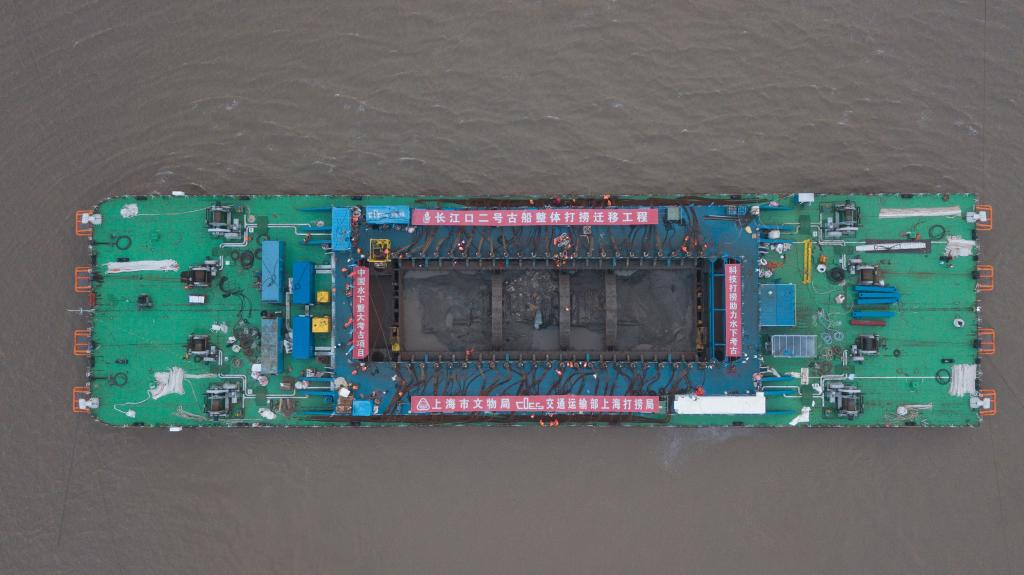
This aerial photo taken on Nov. 21, 2022 shows a view of the salvage operation of the Yangtze No. 2 Ancient Shipwreck in Shanghai, east China. An ancient shipwreck, one of the largest and best-preserved wooden shipwrecks discovered underwater in China to date, was lifted out of waters in Shanghai early Monday.(Xinhua/Jin Liwang)
SHANGHAI, Nov. 21 (Xinhua) -- An ancient shipwreck, one of the largest and best-preserved wooden shipwrecks discovered underwater in China to date, was lifted out of waters in Shanghai early Monday.
The Yangtze No. 2 Ancient Shipwreck dates back to the reign of Emperor Tongzhi (1862-1875) of the Qing Dynasty. This salvage could offer a useful glimpse of shipbuilding technology during the Qing Dynasty.
A milestone in China's underwater archaeology efforts, the sunken ship was detected in 2015 during a key underwater survey.
During the following seven years, a series of underwater archaeological fieldwork projects were conducted in the waters off Hengsha island in Shanghai's Chongming District.
According to archaeological investigations, the ship is about 38.1 meters long and 9.9 meters wide. It has 31 cabins and is loaded with exquisite cultural relics such as porcelain made in Jingdezhen, a world-famous "porcelain capital" in east China's Jiangxi Province.
Relics such as purple clay pottery and building materials were also uncovered in and around the shipwreck. Archaeologists believe its excavation could also contribute to the studies of ceramic and economic history in the Qing Dynasty.
The salvage operation saw the use of advanced equipment and technology such as an underwater imaging device -- for muddy water -- and shield tunneling technology.
According to local authorities, the shipwreck will soon be transferred to a dock near the Huangpu River for further preservation and archaeological research. ■

This aerial photo taken on Nov. 21, 2022 shows a view of the salvage operation of the Yangtze No. 2 Ancient Shipwreck in Shanghai, east China. An ancient shipwreck, one of the largest and best-preserved wooden shipwrecks discovered underwater in China to date, was lifted out of waters in Shanghai early Monday.
The Yangtze No. 2 Ancient Shipwreck dates back to the reign of Emperor Tongzhi (1862-1875) of the Qing Dynasty. This salvage could offer a useful glimpse of shipbuilding technology during the Qing Dynasty.
A milestone in China's underwater archaeology efforts, the sunken ship was detected in 2015 during a key underwater survey. (Xinhua/Jin Liwang)
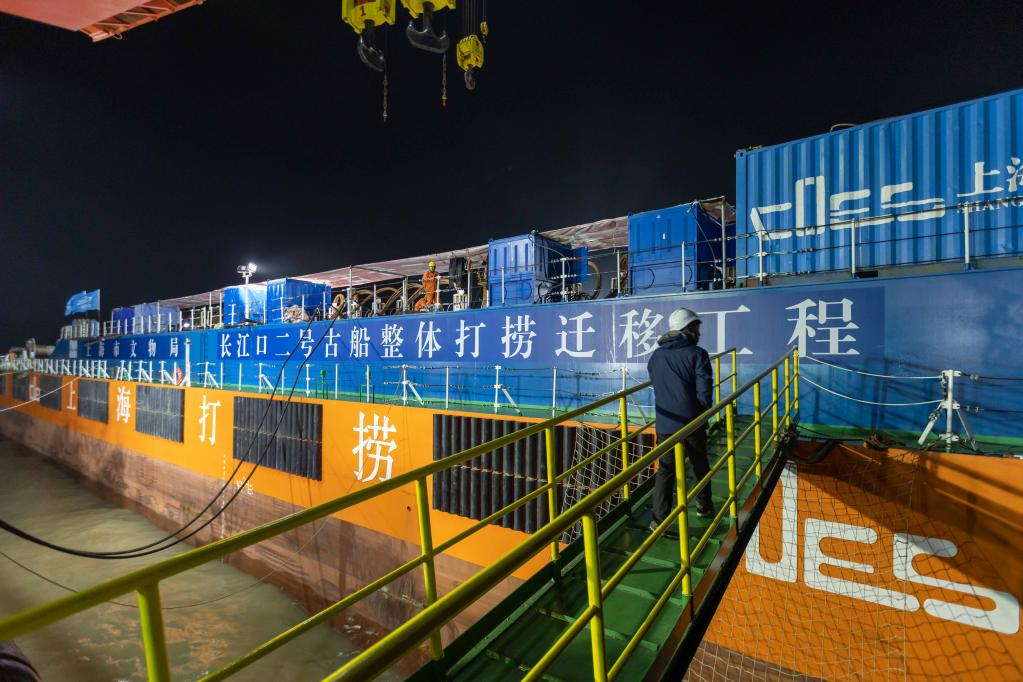
This photo taken on Nov. 20, 2022 shows a view of the salvage operation of the Yangtze No. 2 Ancient Shipwreck in Shanghai, east China. An ancient shipwreck, one of the largest and best-preserved wooden shipwrecks discovered underwater in China to date, was lifted out of waters in Shanghai early Monday.
The Yangtze No. 2 Ancient Shipwreck dates back to the reign of Emperor Tongzhi (1862-1875) of the Qing Dynasty. This salvage could offer a useful glimpse of shipbuilding technology during the Qing Dynasty.
A milestone in China's underwater archaeology efforts, the sunken ship was detected in 2015 during a key underwater survey. (Xinhua/Wang Xiang)
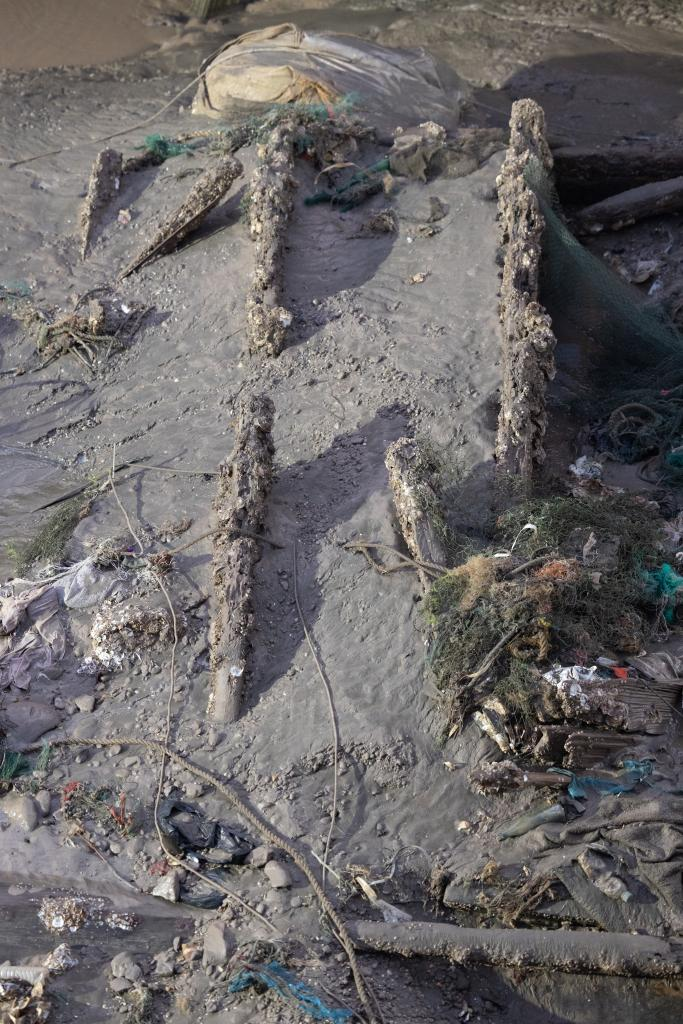
This photo taken on Nov. 21, 2022 shows a part of the Yangtze No. 2 Ancient Shipwreck lifted out of waters in Shanghai, east China. An ancient shipwreck, one of the largest and best-preserved wooden shipwrecks discovered underwater in China to date, was lifted out of waters in Shanghai early Monday.
The Yangtze No. 2 Ancient Shipwreck dates back to the reign of Emperor Tongzhi (1862-1875) of the Qing Dynasty. This salvage could offer a useful glimpse of shipbuilding technology during the Qing Dynasty.
A milestone in China's underwater archaeology efforts, the sunken ship was detected in 2015 during a key underwater survey. (Xinhua/Jin Liwang)
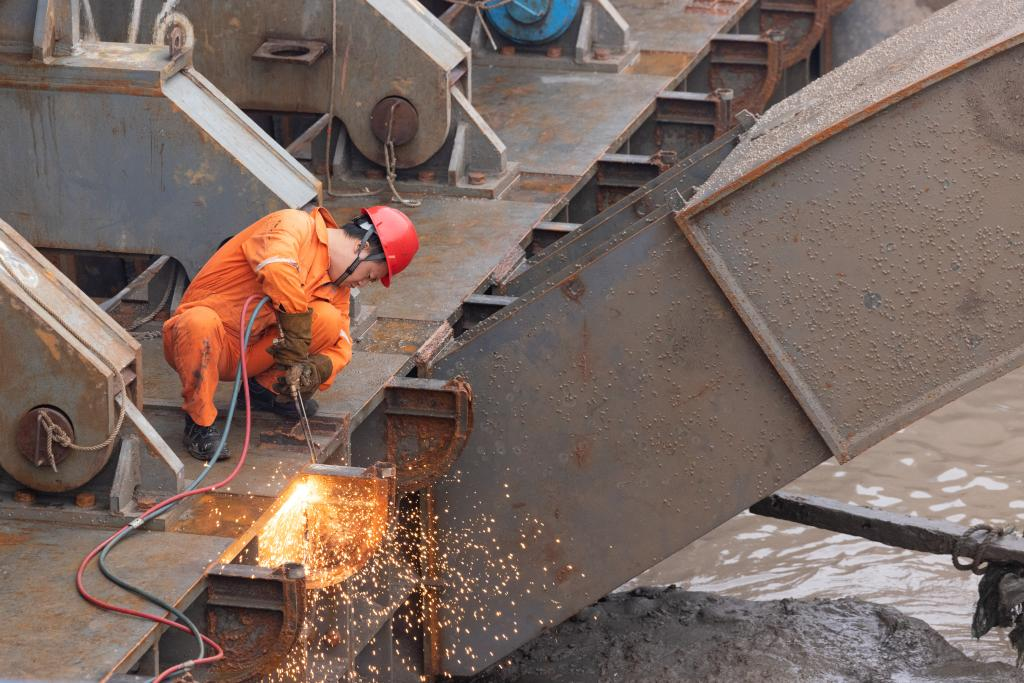
A worker fixes the body of the Yangtze No. 2 Ancient Shipwreck at the salvage operation site in Shanghai, east China, on Nov. 21, 2022. An ancient shipwreck, one of the largest and best-preserved wooden shipwrecks discovered underwater in China to date, was lifted out of waters in Shanghai early Monday.
The Yangtze No. 2 Ancient Shipwreck dates back to the reign of Emperor Tongzhi (1862-1875) of the Qing Dynasty. This salvage could offer a useful glimpse of shipbuilding technology during the Qing Dynasty.
A milestone in China's underwater archaeology efforts, the sunken ship was detected in 2015 during a key underwater survey. (Xinhua/Jin Liwang)
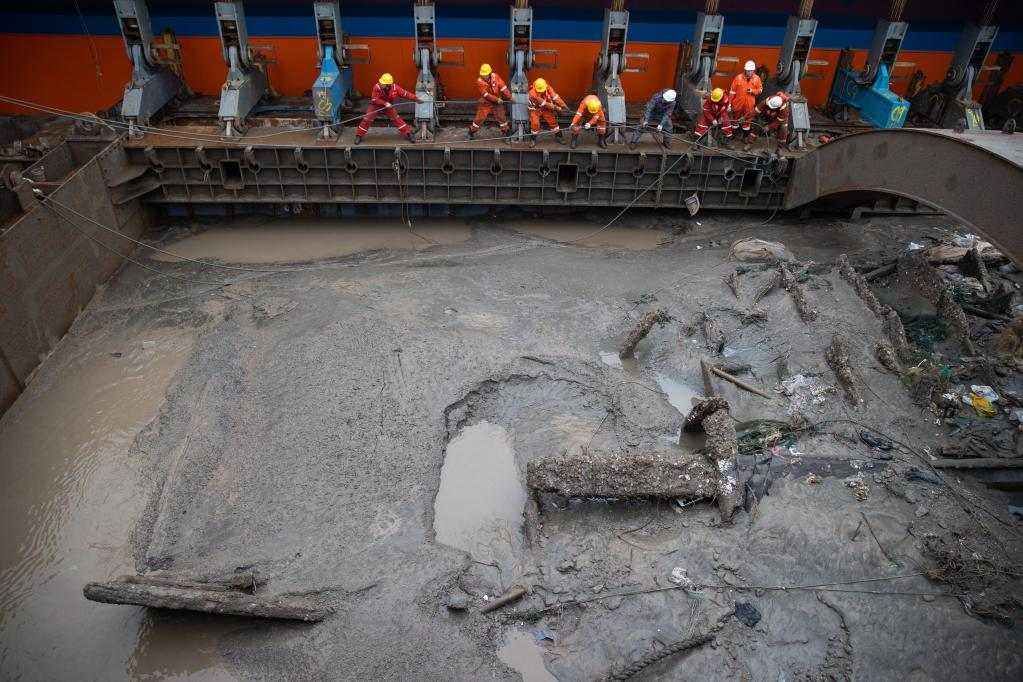
This photo taken on Nov. 21, 2022 shows a view of the salvage operation of the Yangtze No. 2 Ancient Shipwreck in Shanghai, east China. An ancient shipwreck, one of the largest and best-preserved wooden shipwrecks discovered underwater in China to date, was lifted out of waters in Shanghai early Monday.
The Yangtze No. 2 Ancient Shipwreck dates back to the reign of Emperor Tongzhi (1862-1875) of the Qing Dynasty. This salvage could offer a useful glimpse of shipbuilding technology during the Qing Dynasty.
A milestone in China's underwater archaeology efforts, the sunken ship was detected in 2015 during a key underwater survey. (Xinhua/Jin Liwang)
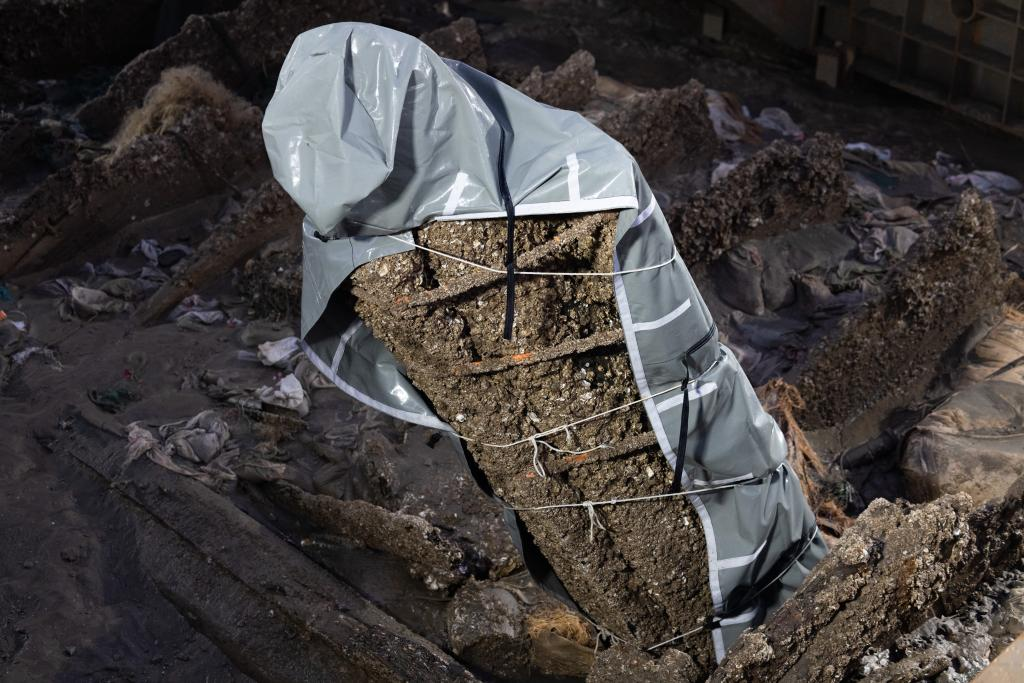
This photo taken on Nov. 21, 2022 shows the protected mast of the Yangtze No. 2 Ancient Shipwreck lifted out of waters in Shanghai, east China. An ancient shipwreck, one of the largest and best-preserved wooden shipwrecks discovered underwater in China to date, was lifted out of waters in Shanghai early Monday.
The Yangtze No. 2 Ancient Shipwreck dates back to the reign of Emperor Tongzhi (1862-1875) of the Qing Dynasty. This salvage could offer a useful glimpse of shipbuilding technology during the Qing Dynasty.
A milestone in China's underwater archaeology efforts, the sunken ship was detected in 2015 during a key underwater survey. (Xinhua/Jin Liwang)
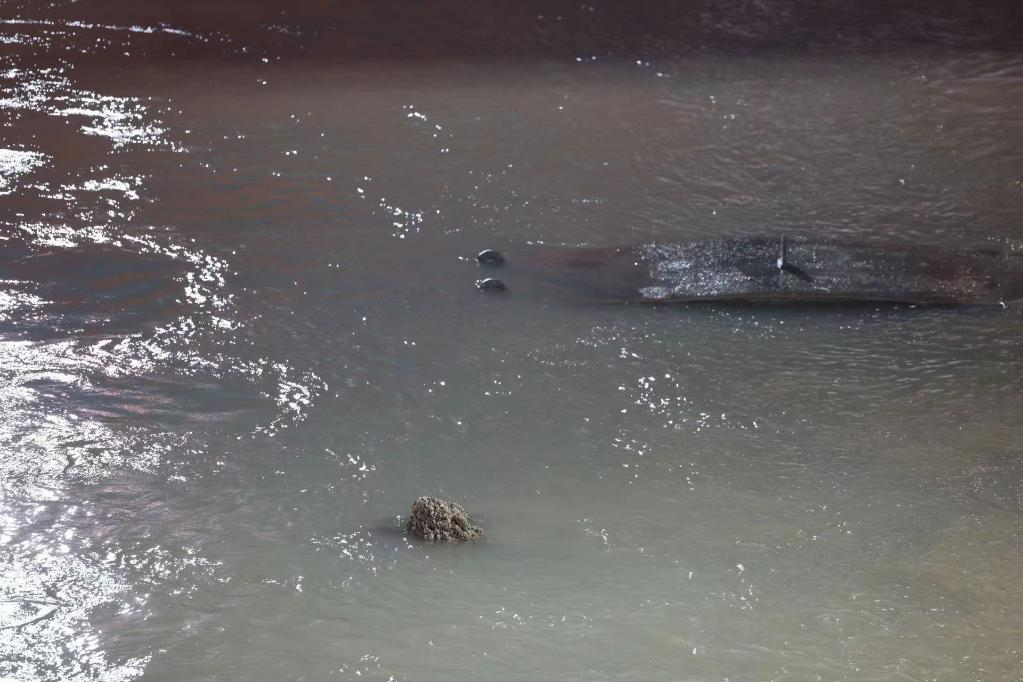
This photo taken on Nov. 21, 2022 shows the mast of the Yangtze No. 2 Ancient Shipwreck surfacing at the salvage operation site in Shanghai, east China. An ancient shipwreck, one of the largest and best-preserved wooden shipwrecks discovered underwater in China to date, was lifted out of waters in Shanghai early Monday.
The Yangtze No. 2 Ancient Shipwreck dates back to the reign of Emperor Tongzhi (1862-1875) of the Qing Dynasty. This salvage could offer a useful glimpse of shipbuilding technology during the Qing Dynasty.
A milestone in China's underwater archaeology efforts, the sunken ship was detected in 2015 during a key underwater survey. (Xinhua/Jin Liwang)
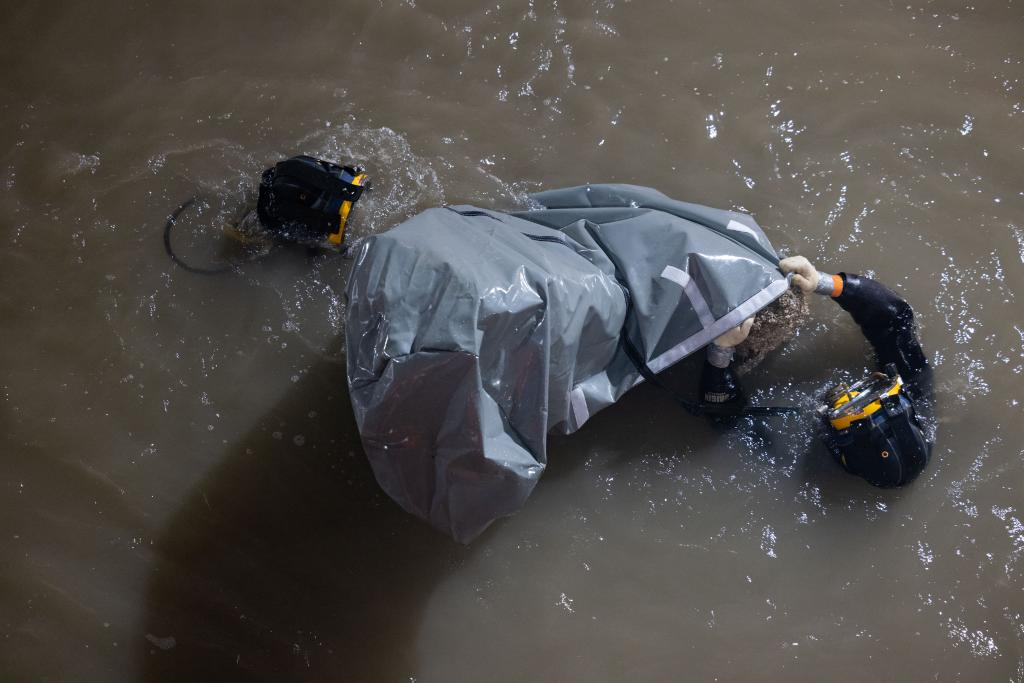
Staff members wrap up the mast of the Yangtze No. 2 Ancient Shipwreck for protection at the salvage operation site in Shanghai, east China, Nov. 21, 2022. An ancient shipwreck, one of the largest and best-preserved wooden shipwrecks discovered underwater in China to date, was lifted out of waters in Shanghai early Monday.
The Yangtze No. 2 Ancient Shipwreck dates back to the reign of Emperor Tongzhi (1862-1875) of the Qing Dynasty. This salvage could offer a useful glimpse of shipbuilding technology during the Qing Dynasty.
A milestone in China's underwater archaeology efforts, the sunken ship was detected in 2015 during a key underwater survey. (Xinhua/Jin Liwang)

This photo taken on Nov. 21, 2022 shows the protected mast of the Yangtze No. 2 Ancient Shipwreck lifted out of waters in Shanghai, east China. An ancient shipwreck, one of the largest and best-preserved wooden shipwrecks discovered underwater in China to date, was lifted out of waters in Shanghai early Monday.
The Yangtze No. 2 Ancient Shipwreck dates back to the reign of Emperor Tongzhi (1862-1875) of the Qing Dynasty. This salvage could offer a useful glimpse of shipbuilding technology during the Qing Dynasty.
A milestone in China's underwater archaeology efforts, the sunken ship was detected in 2015 during a key underwater survey. (Xinhua/Wang Xiang)
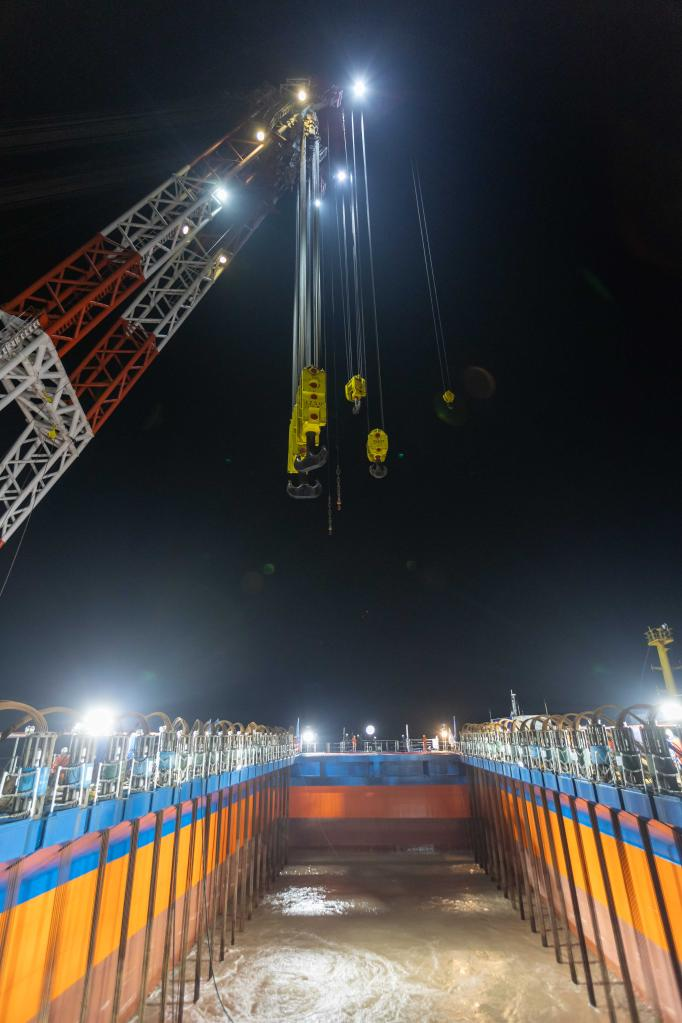
This photo taken on Nov. 20, 2022 shows a view of the salvage operation of the Yangtze No. 2 Ancient Shipwreck in Shanghai, east China. An ancient shipwreck, one of the largest and best-preserved wooden shipwrecks discovered underwater in China to date, was lifted out of waters in Shanghai early Monday.
The Yangtze No. 2 Ancient Shipwreck dates back to the reign of Emperor Tongzhi (1862-1875) of the Qing Dynasty. This salvage could offer a useful glimpse of shipbuilding technology during the Qing Dynasty.
A milestone in China's underwater archaeology efforts, the sunken ship was detected in 2015 during a key underwater survey. (Xinhua/Wang Xiang)

This photo taken on Nov. 20, 2022 shows a view of the salvage operation of the Yangtze No. 2 Ancient Shipwreck in Shanghai, east China. An ancient shipwreck, one of the largest and best-preserved wooden shipwrecks discovered underwater in China to date, was lifted out of waters in Shanghai early Monday.
The Yangtze No. 2 Ancient Shipwreck dates back to the reign of Emperor Tongzhi (1862-1875) of the Qing Dynasty. This salvage could offer a useful glimpse of shipbuilding technology during the Qing Dynasty.
A milestone in China's underwater archaeology efforts, the sunken ship was detected in 2015 during a key underwater survey. (Xinhua/Ding Ting)
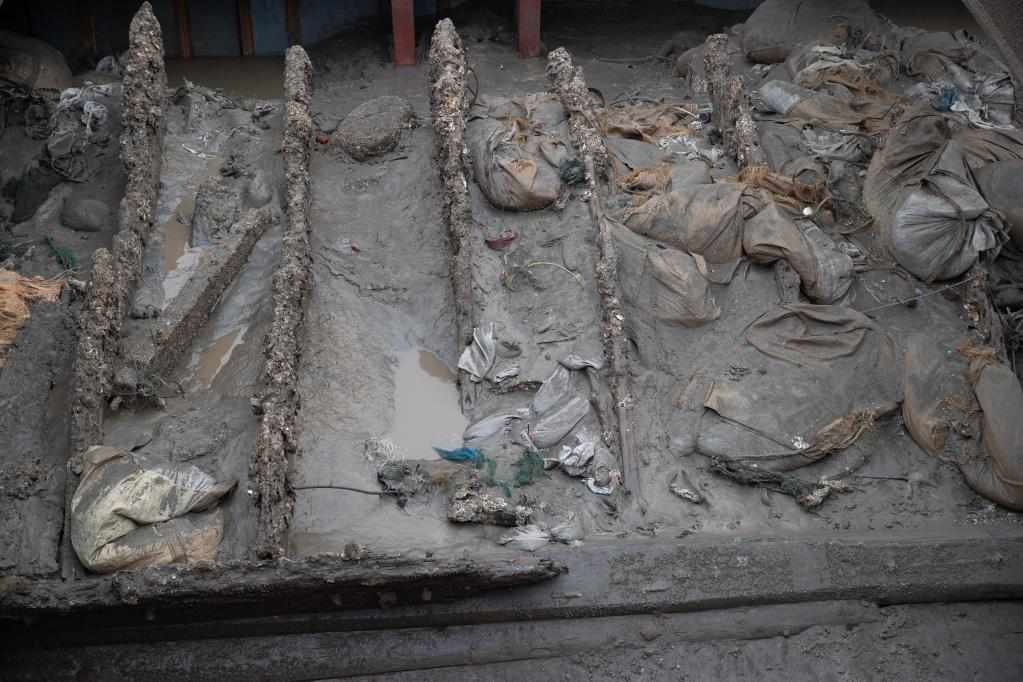
This photo taken on Nov. 21, 2022 shows a part of the Yangtze No. 2 Ancient Shipwreck lifted out of waters in Shanghai, east China. An ancient shipwreck, one of the largest and best-preserved wooden shipwrecks discovered underwater in China to date, was lifted out of waters in Shanghai early Monday.
The Yangtze No. 2 Ancient Shipwreck dates back to the reign of Emperor Tongzhi (1862-1875) of the Qing Dynasty. This salvage could offer a useful glimpse of shipbuilding technology during the Qing Dynasty.
A milestone in China's underwater archaeology efforts, the sunken ship was detected in 2015 during a key underwater survey. (Xinhua/Jin Liwang)
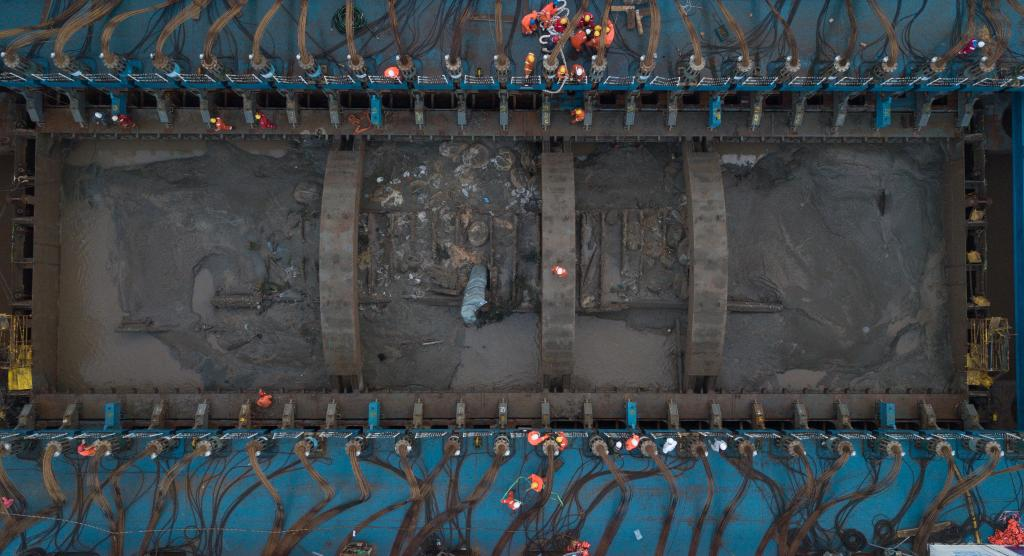
This aerial photo taken on Nov. 21, 2022 shows a view of the salvage operation of the Yangtze No. 2 Ancient Shipwreck in Shanghai, east China. An ancient shipwreck, one of the largest and best-preserved wooden shipwrecks discovered underwater in China to date, was lifted out of waters in Shanghai early Monday.
The Yangtze No. 2 Ancient Shipwreck dates back to the reign of Emperor Tongzhi (1862-1875) of the Qing Dynasty. This salvage could offer a useful glimpse of shipbuilding technology during the Qing Dynasty.
A milestone in China's underwater archaeology efforts, the sunken ship was detected in 2015 during a key underwater survey. (Xinhua/Jin Liwang)
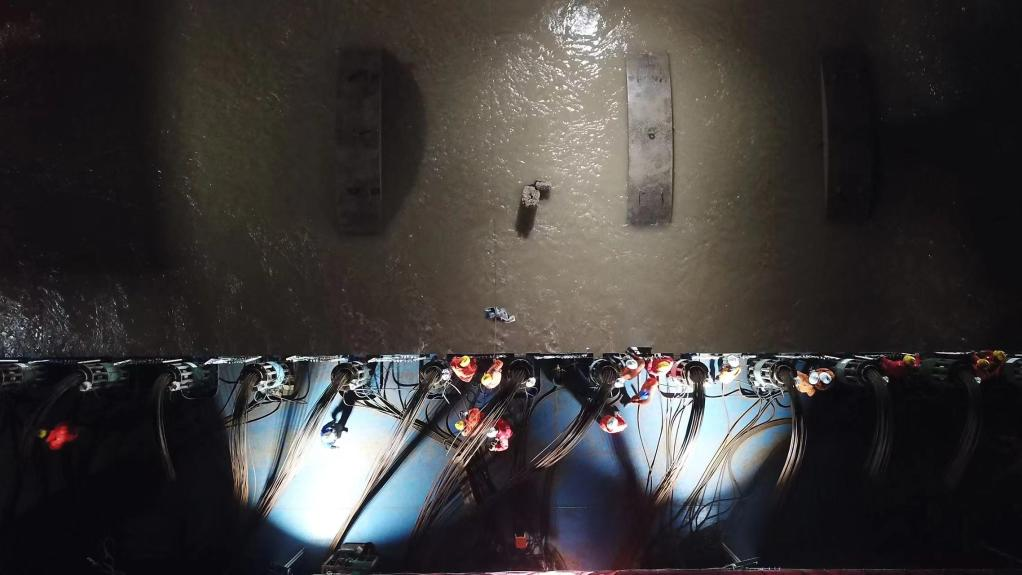
This photo taken on Nov. 21, 2022 shows the mast of the Yangtze No. 2 Ancient Shipwreck surfacing at the salvage operation site in Shanghai, east China. An ancient shipwreck, one of the largest and best-preserved wooden shipwrecks discovered underwater in China to date, was lifted out of waters in Shanghai early Monday.
The Yangtze No. 2 Ancient Shipwreck dates back to the reign of Emperor Tongzhi (1862-1875) of the Qing Dynasty. This salvage could offer a useful glimpse of shipbuilding technology during the Qing Dynasty.
A milestone in China's underwater archaeology efforts, the sunken ship was detected in 2015 during a key underwater survey. (Xinhua/Jin Liwang)
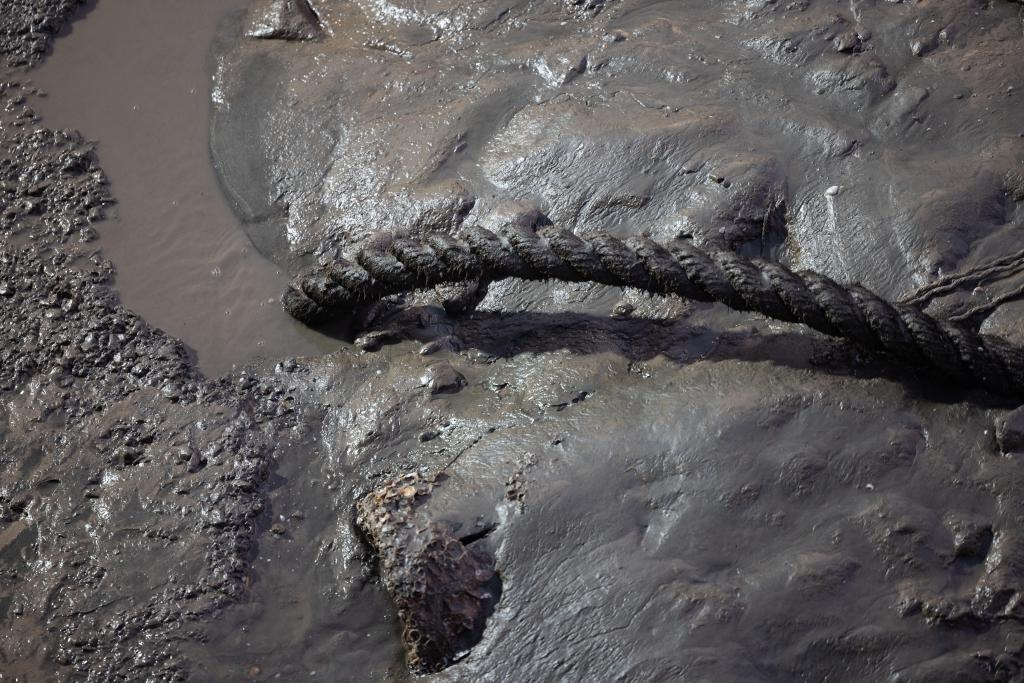
This photo taken on Nov. 21, 2022 shows a part of the Yangtze No. 2 Ancient Shipwreck lifted out of waters in Shanghai, east China. An ancient shipwreck, one of the largest and best-preserved wooden shipwrecks discovered underwater in China to date, was lifted out of waters in Shanghai early Monday.
The Yangtze No. 2 Ancient Shipwreck dates back to the reign of Emperor Tongzhi (1862-1875) of the Qing Dynasty. This salvage could offer a useful glimpse of shipbuilding technology during the Qing Dynasty.
A milestone in China's underwater archaeology efforts, the sunken ship was detected in 2015 during a key underwater survey. (Xinhua/Jin Liwang)
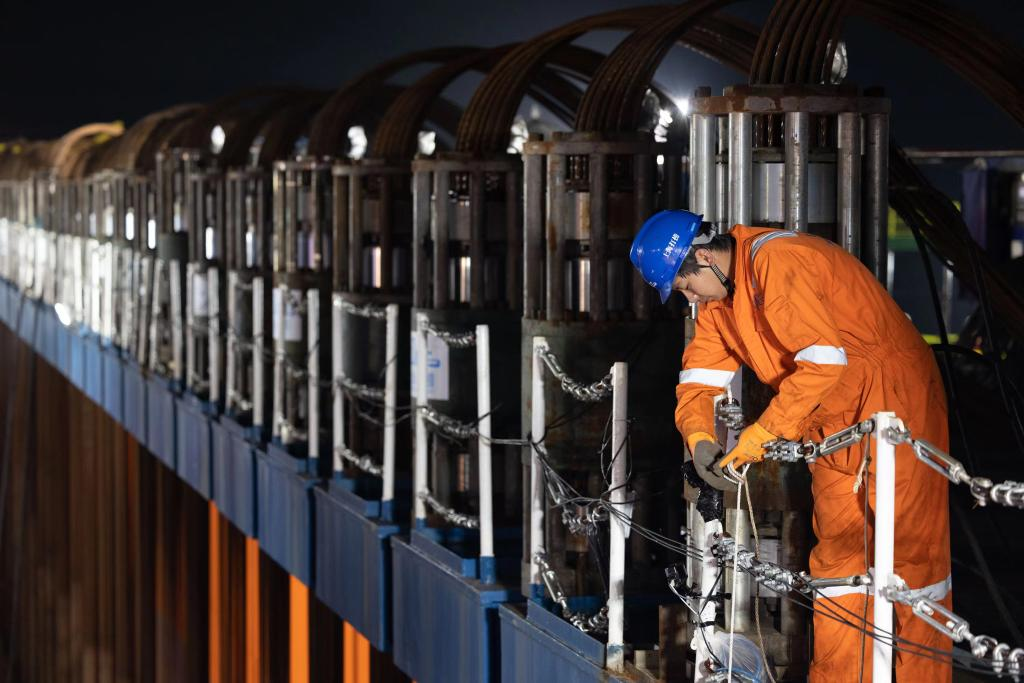
A worker checks the lifting of the Yangtze No. 2 Ancient Shipwreck at the salvage operation site in Shanghai, east China, Nov. 21, 2022. An ancient shipwreck, one of the largest and best-preserved wooden shipwrecks discovered underwater in China to date, was lifted out of waters in Shanghai early Monday.
The Yangtze No. 2 Ancient Shipwreck dates back to the reign of Emperor Tongzhi (1862-1875) of the Qing Dynasty. This salvage could offer a useful glimpse of shipbuilding technology during the Qing Dynasty.
A milestone in China's underwater archaeology efforts, the sunken ship was detected in 2015 during a key underwater survey. (Xinhua/Jin Liwang)
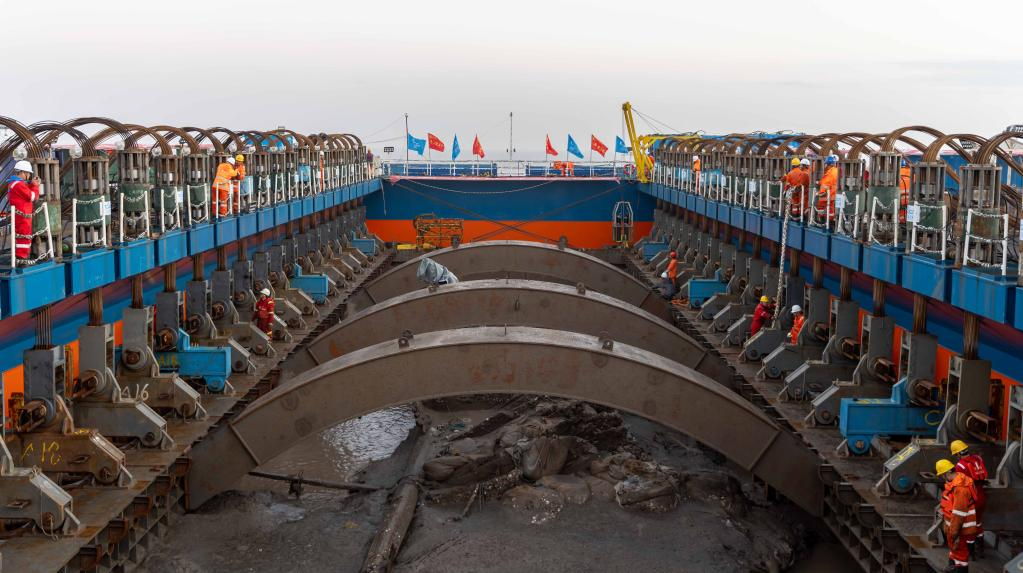
This photo taken on Nov. 21, 2022 shows a view of the salvage operation of the Yangtze No. 2 Ancient Shipwreck in Shanghai, east China. An ancient shipwreck, one of the largest and best-preserved wooden shipwrecks discovered underwater in China to date, was lifted out of waters in Shanghai early Monday.
The Yangtze No. 2 Ancient Shipwreck dates back to the reign of Emperor Tongzhi (1862-1875) of the Qing Dynasty. This salvage could offer a useful glimpse of shipbuilding technology during the Qing Dynasty.
A milestone in China's underwater archaeology efforts, the sunken ship was detected in 2015 during a key underwater survey. (Xinhua/Wang Xiang)
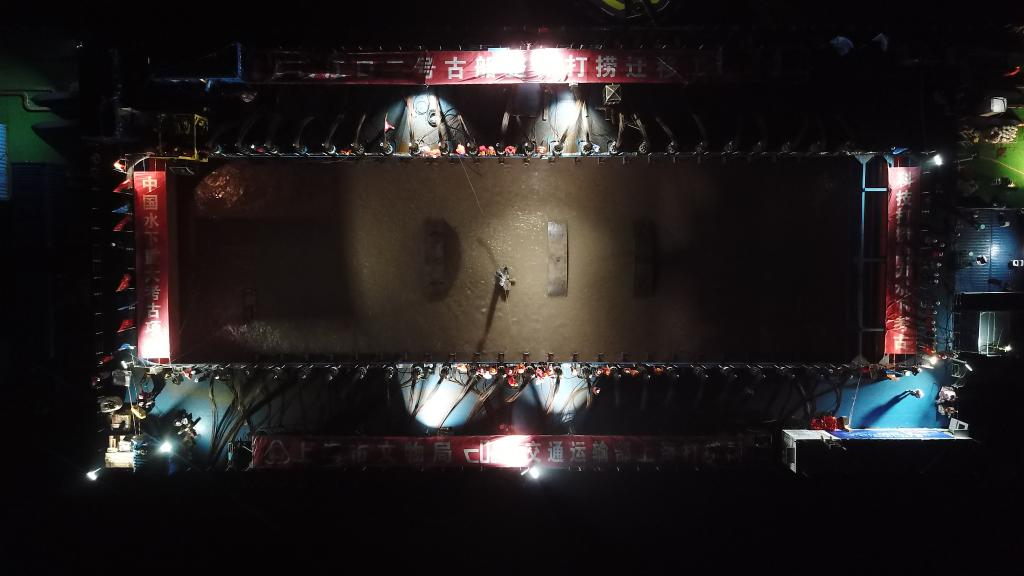
This aerial photo taken on Nov. 21, 2022 shows a view of the salvage operation of the Yangtze No. 2 Ancient Shipwreck in Shanghai, east China. An ancient shipwreck, one of the largest and best-preserved wooden shipwrecks discovered underwater in China to date, was lifted out of waters in Shanghai early Monday.
The Yangtze No. 2 Ancient Shipwreck dates back to the reign of Emperor Tongzhi (1862-1875) of the Qing Dynasty. This salvage could offer a useful glimpse of shipbuilding technology during the Qing Dynasty.
A milestone in China's underwater archaeology efforts, the sunken ship was detected in 2015 during a key underwater survey. (Xinhua/Jin Liwang)
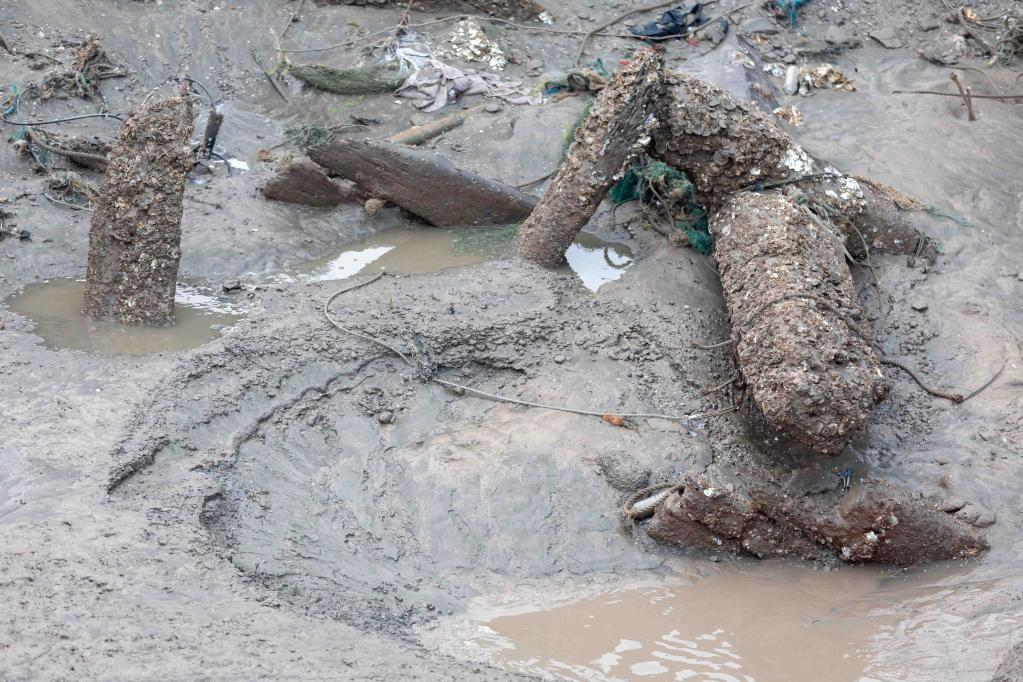
This photo taken on Nov. 21, 2022 shows a part of the Yangtze No. 2 Ancient Shipwreck lifted out of waters in Shanghai, east China. An ancient shipwreck, one of the largest and best-preserved wooden shipwrecks discovered underwater in China to date, was lifted out of waters in Shanghai early Monday.
The Yangtze No. 2 Ancient Shipwreck dates back to the reign of Emperor Tongzhi (1862-1875) of the Qing Dynasty. This salvage could offer a useful glimpse of shipbuilding technology during the Qing Dynasty.
A milestone in China's underwater archaeology efforts, the sunken ship was detected in 2015 during a key underwater survey. (Xinhua/Wang Xiang)
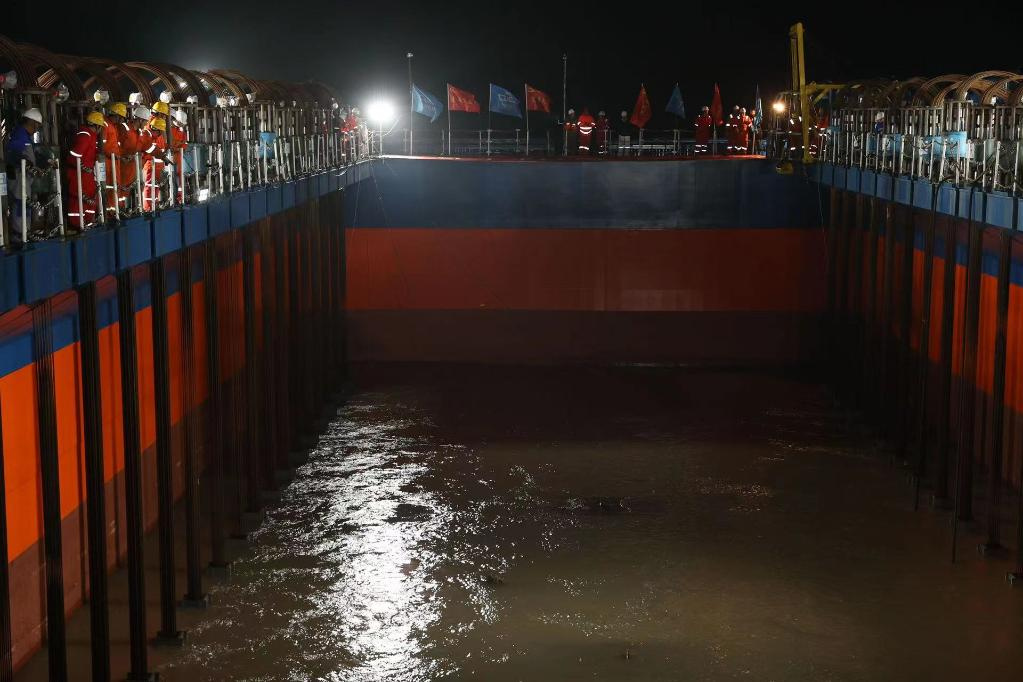
This photo taken on Nov. 21, 2022 shows the mast of the Yangtze No. 2 Ancient Shipwreck surfacing at the salvage operation site in Shanghai, east China. An ancient shipwreck, one of the largest and best-preserved wooden shipwrecks discovered underwater in China to date, was lifted out of waters in Shanghai early Monday.
The Yangtze No. 2 Ancient Shipwreck dates back to the reign of Emperor Tongzhi (1862-1875) of the Qing Dynasty. This salvage could offer a useful glimpse of shipbuilding technology during the Qing Dynasty.
A milestone in China's underwater archaeology efforts, the sunken ship was detected in 2015 during a key underwater survey. (Xinhua/Jin Liwang)
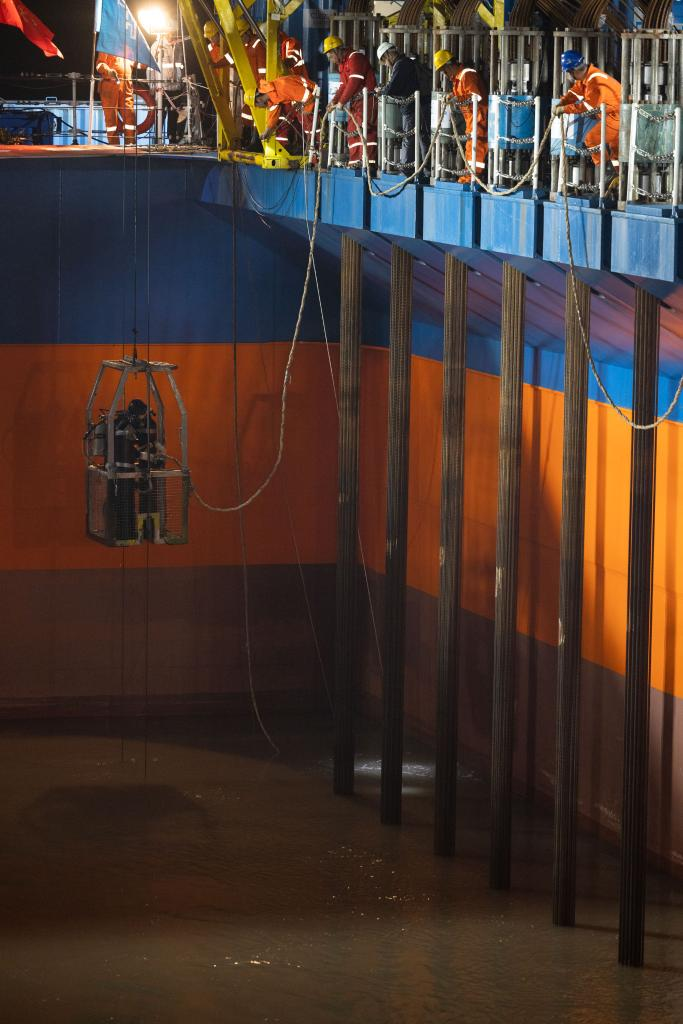
This photo taken on Nov. 20, 2022 shows a view of the salvage operation of the Yangtze No. 2 Ancient Shipwreck in Shanghai, east China. An ancient shipwreck, one of the largest and best-preserved wooden shipwrecks discovered underwater in China to date, was lifted out of waters in Shanghai early Monday.
The Yangtze No. 2 Ancient Shipwreck dates back to the reign of Emperor Tongzhi (1862-1875) of the Qing Dynasty. This salvage could offer a useful glimpse of shipbuilding technology during the Qing Dynasty.
A milestone in China's underwater archaeology efforts, the sunken ship was detected in 2015 during a key underwater survey. (Xinhua/Jin Liwang)
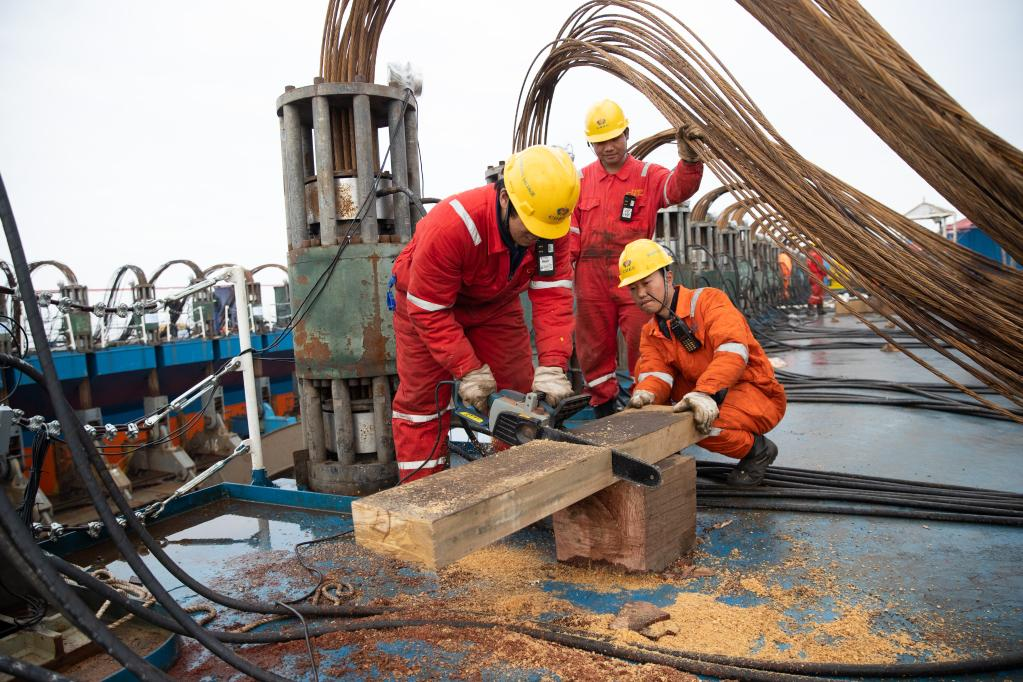
Workers prepare items to fix the body of the Yangtze No. 2 Ancient Shipwreck at the salvage operation site in Shanghai, east China, on Nov. 21, 2022. An ancient shipwreck, one of the largest and best-preserved wooden shipwrecks discovered underwater in China to date, was lifted out of waters in Shanghai early Monday.
The Yangtze No. 2 Ancient Shipwreck dates back to the reign of Emperor Tongzhi (1862-1875) of the Qing Dynasty. This salvage could offer a useful glimpse of shipbuilding technology during the Qing Dynasty.
A milestone in China's underwater archaeology efforts, the sunken ship was detected in 2015 during a key underwater survey. (Xinhua/Jin Liwang)
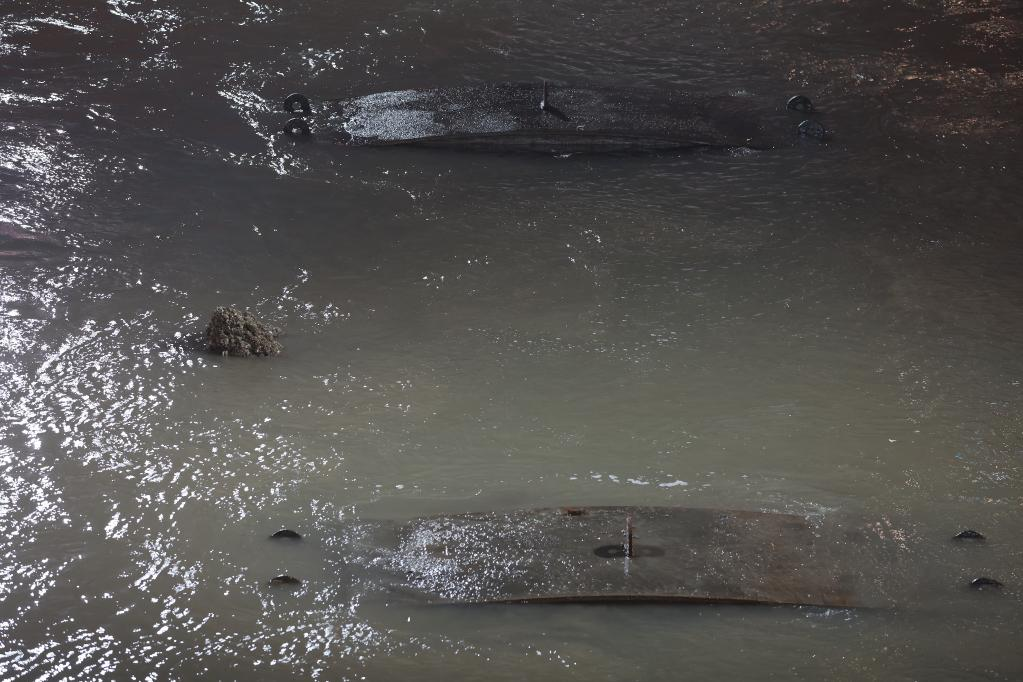
This photo taken on Nov. 21, 2022 shows the mast of the Yangtze No. 2 Ancient Shipwreck (L, C) surfacing at the salvage operation site in Shanghai, east China. An ancient shipwreck, one of the largest and best-preserved wooden shipwrecks discovered underwater in China to date, was lifted out of waters in Shanghai early Monday.
The Yangtze No. 2 Ancient Shipwreck dates back to the reign of Emperor Tongzhi (1862-1875) of the Qing Dynasty. This salvage could offer a useful glimpse of shipbuilding technology during the Qing Dynasty.
A milestone in China's underwater archaeology efforts, the sunken ship was detected in 2015 during a key underwater survey. (Xinhua/Wang Xiang)
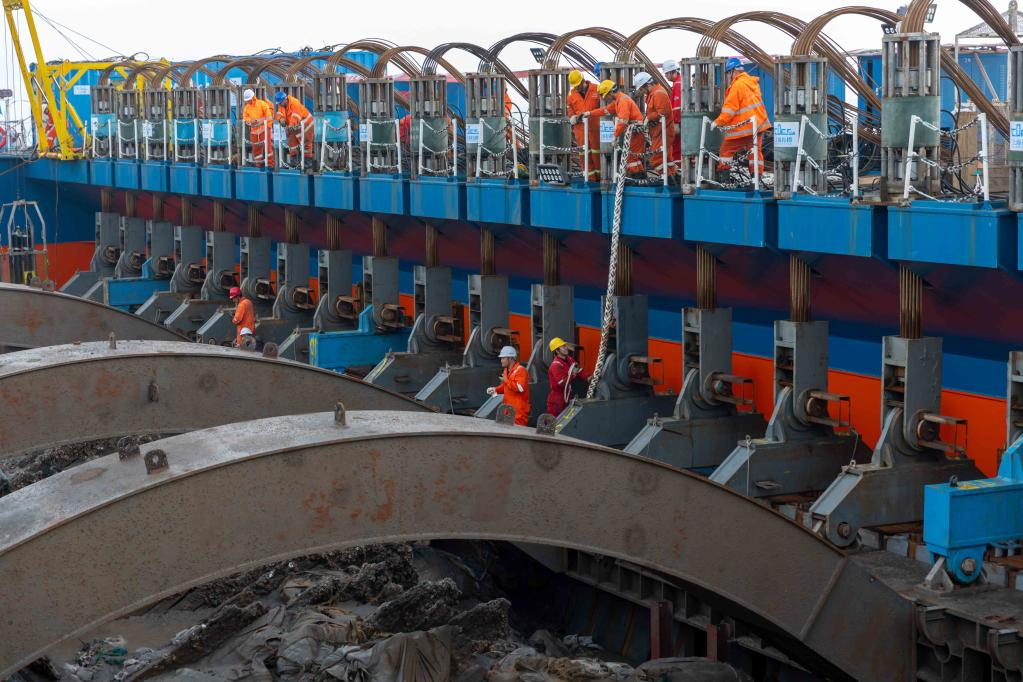
This photo taken on Nov. 21, 2022 shows a view of the salvage operation of the Yangtze No. 2 Ancient Shipwreck in Shanghai, east China. An ancient shipwreck, one of the largest and best-preserved wooden shipwrecks discovered underwater in China to date, was lifted out of waters in Shanghai early Monday.
The Yangtze No. 2 Ancient Shipwreck dates back to the reign of Emperor Tongzhi (1862-1875) of the Qing Dynasty. This salvage could offer a useful glimpse of shipbuilding technology during the Qing Dynasty.
A milestone in China's underwater archaeology efforts, the sunken ship was detected in 2015 during a key underwater survey. (Xinhua/Wang Xiang)
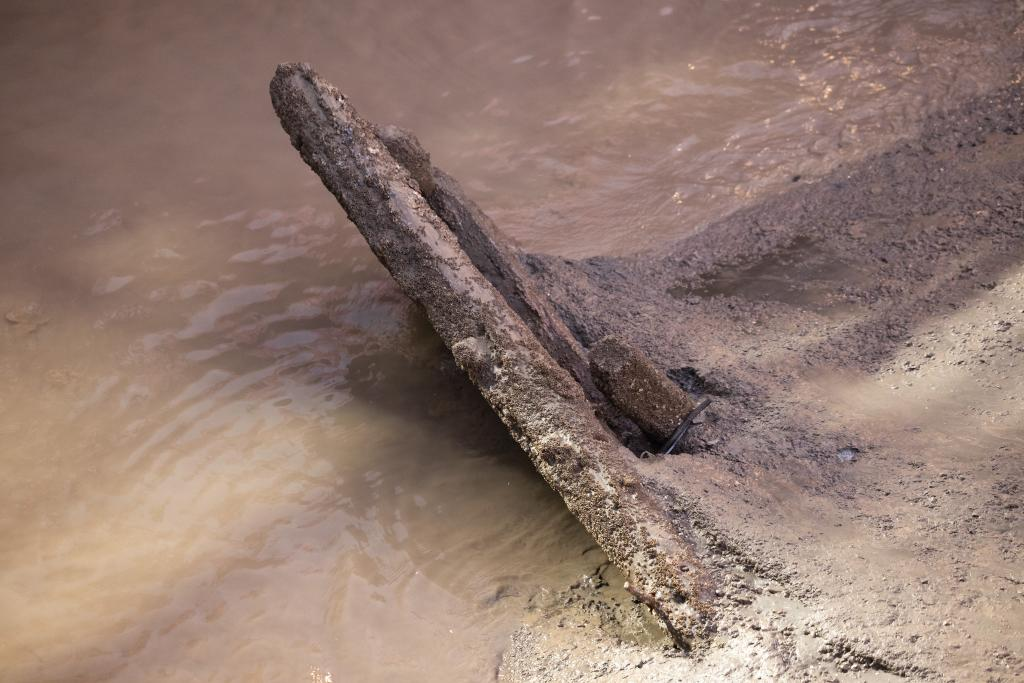
This photo taken on Nov. 21, 2022 shows a part of the Yangtze No. 2 Ancient Shipwreck lifted out of waters in Shanghai, east China. An ancient shipwreck, one of the largest and best-preserved wooden shipwrecks discovered underwater in China to date, was lifted out of waters in Shanghai early Monday.
The Yangtze No. 2 Ancient Shipwreck dates back to the reign of Emperor Tongzhi (1862-1875) of the Qing Dynasty. This salvage could offer a useful glimpse of shipbuilding technology during the Qing Dynasty.
A milestone in China's underwater archaeology efforts, the sunken ship was detected in 2015 during a key underwater survey. (Xinhua/Jin Liwang)
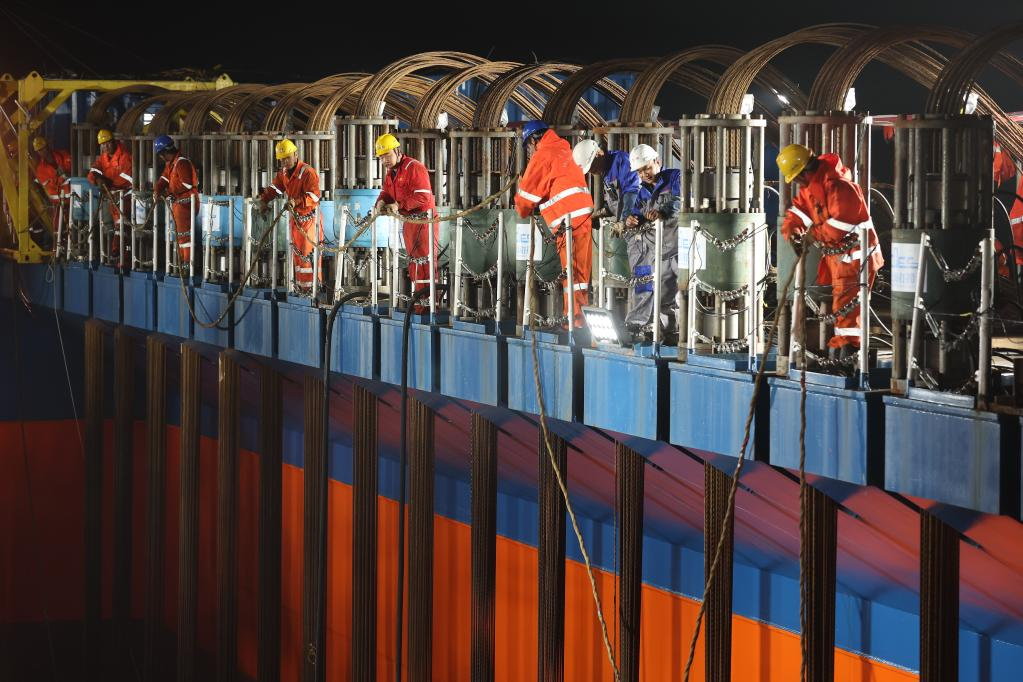
This photo taken on Nov. 21, 2022 shows a view of the salvage operation of the Yangtze No. 2 Ancient Shipwreck in Shanghai, east China. An ancient shipwreck, one of the largest and best-preserved wooden shipwrecks discovered underwater in China to date, was lifted out of waters in Shanghai early Monday.
The Yangtze No. 2 Ancient Shipwreck dates back to the reign of Emperor Tongzhi (1862-1875) of the Qing Dynasty. This salvage could offer a useful glimpse of shipbuilding technology during the Qing Dynasty.
A milestone in China's underwater archaeology efforts, the sunken ship was detected in 2015 during a key underwater survey. (Xinhua/Wang Xiang)
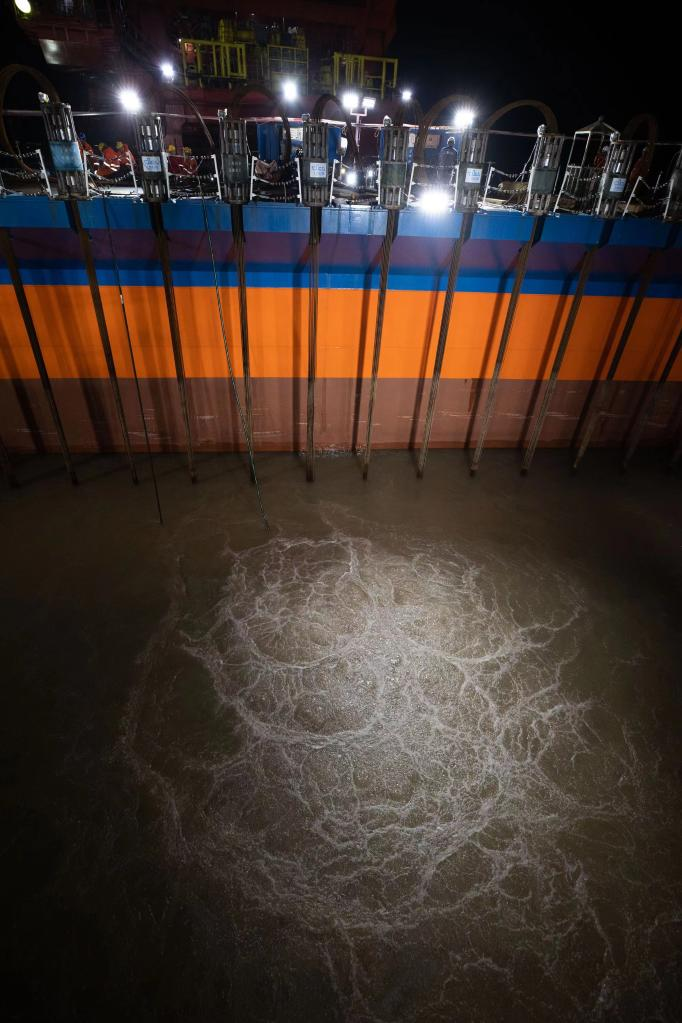
This photo taken on Nov. 20, 2022 shows a view of the salvage operation of the Yangtze No. 2 Ancient Shipwreck in Shanghai, east China. An ancient shipwreck, one of the largest and best-preserved wooden shipwrecks discovered underwater in China to date, was lifted out of waters in Shanghai early Monday.
The Yangtze No. 2 Ancient Shipwreck dates back to the reign of Emperor Tongzhi (1862-1875) of the Qing Dynasty. This salvage could offer a useful glimpse of shipbuilding technology during the Qing Dynasty.
A milestone in China's underwater archaeology efforts, the sunken ship was detected in 2015 during a key underwater survey. (Xinhua/Jin Liwang)
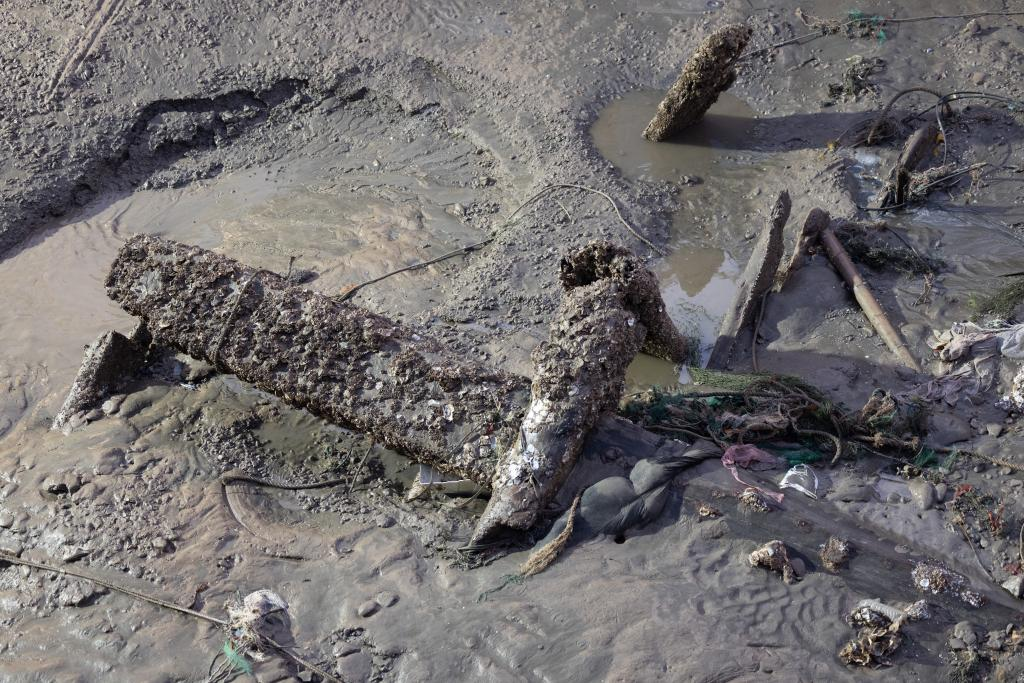
This photo taken on Nov. 21, 2022 shows a part of the Yangtze No. 2 Ancient Shipwreck lifted out of waters in Shanghai, east China. An ancient shipwreck, one of the largest and best-preserved wooden shipwrecks discovered underwater in China to date, was lifted out of waters in Shanghai early Monday.
The Yangtze No. 2 Ancient Shipwreck dates back to the reign of Emperor Tongzhi (1862-1875) of the Qing Dynasty. This salvage could offer a useful glimpse of shipbuilding technology during the Qing Dynasty.
A milestone in China's underwater archaeology efforts, the sunken ship was detected in 2015 during a key underwater survey. (Xinhua/Jin Liwang)
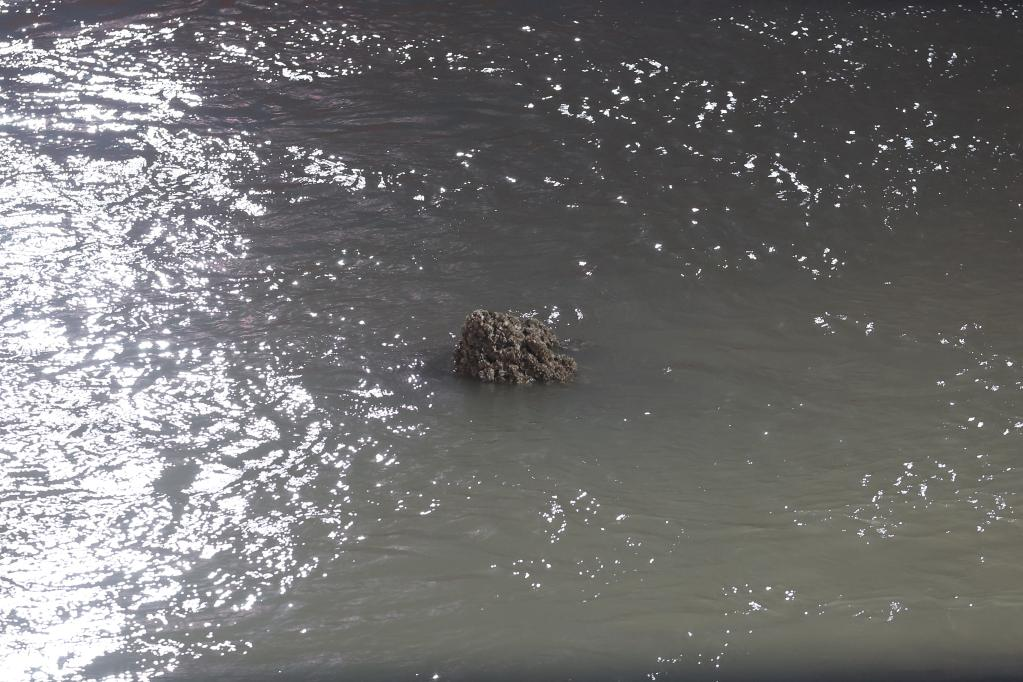
This photo taken on Nov. 21, 2022 shows the mast of the Yangtze No. 2 Ancient Shipwreck surfacing at the salvage operation site in Shanghai, east China. An ancient shipwreck, one of the largest and best-preserved wooden shipwrecks discovered underwater in China to date, was lifted out of waters in Shanghai early Monday.
The Yangtze No. 2 Ancient Shipwreck dates back to the reign of Emperor Tongzhi (1862-1875) of the Qing Dynasty. This salvage could offer a useful glimpse of shipbuilding technology during the Qing Dynasty.
A milestone in China's underwater archaeology efforts, the sunken ship was detected in 2015 during a key underwater survey. (Xinhua/Wang Xiang)
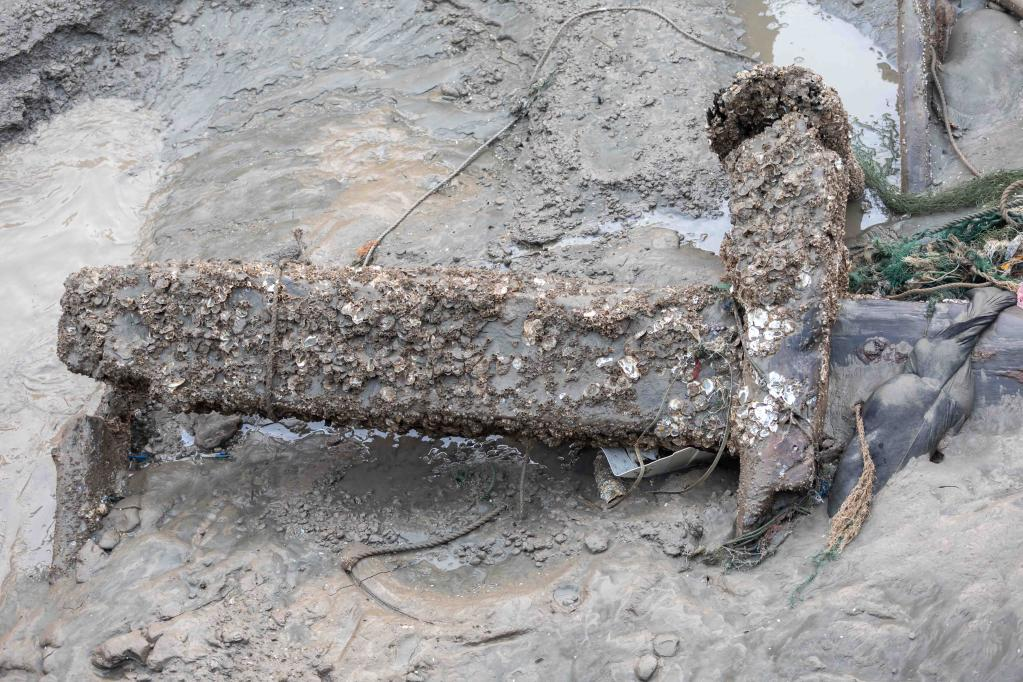
This photo taken on Nov. 21, 2022 shows a part of the Yangtze No. 2 Ancient Shipwreck lifted out of waters in Shanghai, east China. An ancient shipwreck, one of the largest and best-preserved wooden shipwrecks discovered underwater in China to date, was lifted out of waters in Shanghai early Monday.
The Yangtze No. 2 Ancient Shipwreck dates back to the reign of Emperor Tongzhi (1862-1875) of the Qing Dynasty. This salvage could offer a useful glimpse of shipbuilding technology during the Qing Dynasty.
A milestone in China's underwater archaeology efforts, the sunken ship was detected in 2015 during a key underwater survey. (Xinhua/Wang Xiang)
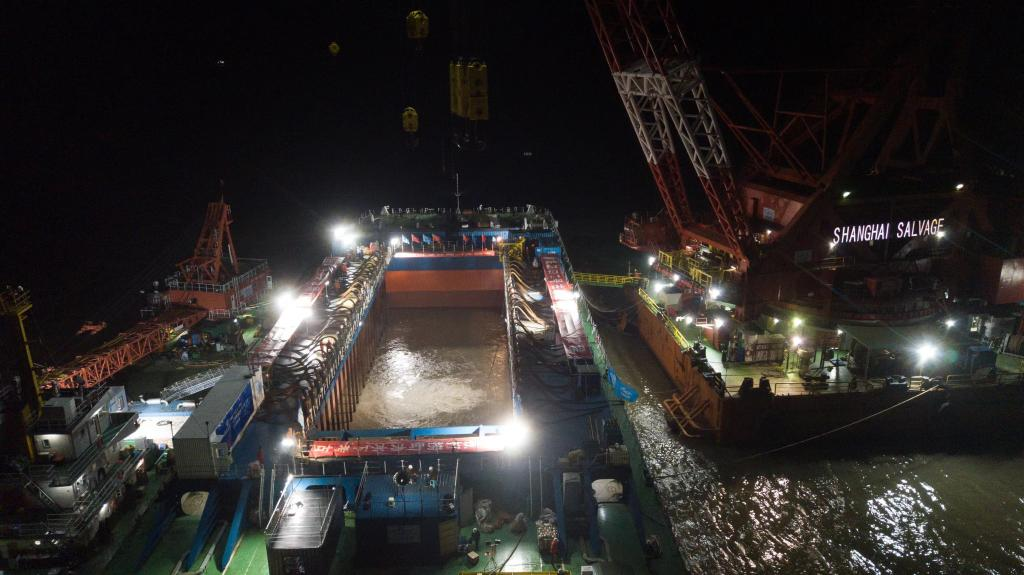
This aerial photo taken on Nov. 20, 2022 shows a view of the salvage operation of the Yangtze No. 2 Ancient Shipwreck in Shanghai, east China. An ancient shipwreck, one of the largest and best-preserved wooden shipwrecks discovered underwater in China to date, was lifted out of waters in Shanghai early Monday.
The Yangtze No. 2 Ancient Shipwreck dates back to the reign of Emperor Tongzhi (1862-1875) of the Qing Dynasty. This salvage could offer a useful glimpse of shipbuilding technology during the Qing Dynasty.
A milestone in China's underwater archaeology efforts, the sunken ship was detected in 2015 during a key underwater survey. (Xinhua/Jin Liwang)
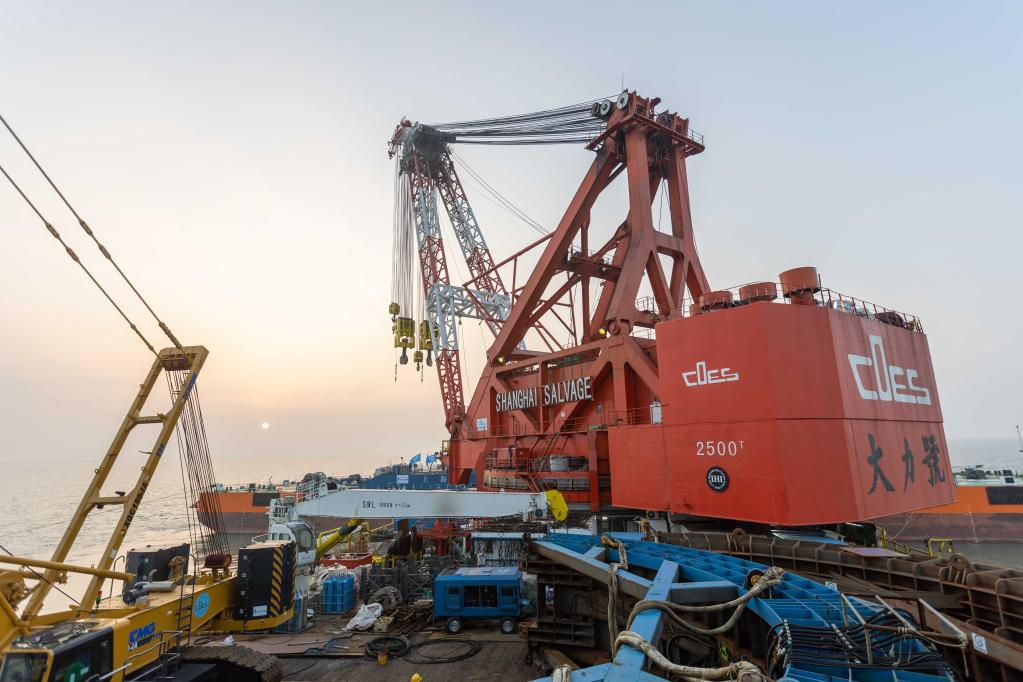
This photo taken on Nov. 20, 2022 shows a view of the salvage operation of the Yangtze No. 2 Ancient Shipwreck in Shanghai, east China. An ancient shipwreck, one of the largest and best-preserved wooden shipwrecks discovered underwater in China to date, was lifted out of waters in Shanghai early Monday.
The Yangtze No. 2 Ancient Shipwreck dates back to the reign of Emperor Tongzhi (1862-1875) of the Qing Dynasty. This salvage could offer a useful glimpse of shipbuilding technology during the Qing Dynasty.
A milestone in China's underwater archaeology efforts, the sunken ship was detected in 2015 during a key underwater survey. (Xinhua/Wang Xiang)
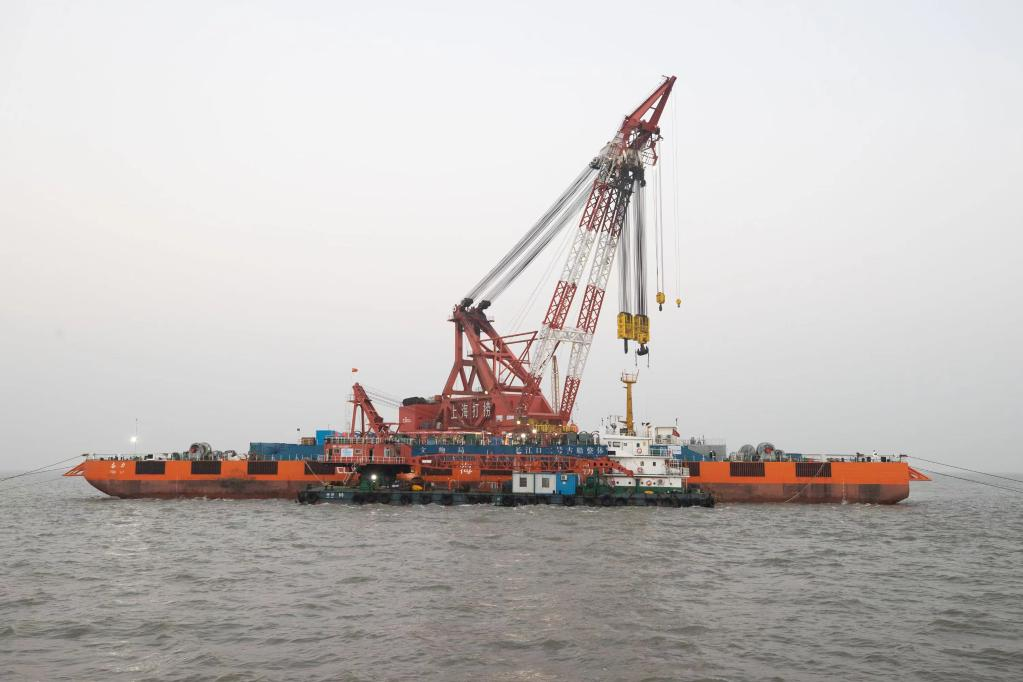
This photo taken on Nov. 20, 2022 shows a view of the salvage operation of the Yangtze No. 2 Ancient Shipwreck in Shanghai, east China. An ancient shipwreck, one of the largest and best-preserved wooden shipwrecks discovered underwater in China to date, was lifted out of waters in Shanghai early Monday.
The Yangtze No. 2 Ancient Shipwreck dates back to the reign of Emperor Tongzhi (1862-1875) of the Qing Dynasty. This salvage could offer a useful glimpse of shipbuilding technology during the Qing Dynasty.
A milestone in China's underwater archaeology efforts, the sunken ship was detected in 2015 during a key underwater survey. (Xinhua/Jin Liwang)
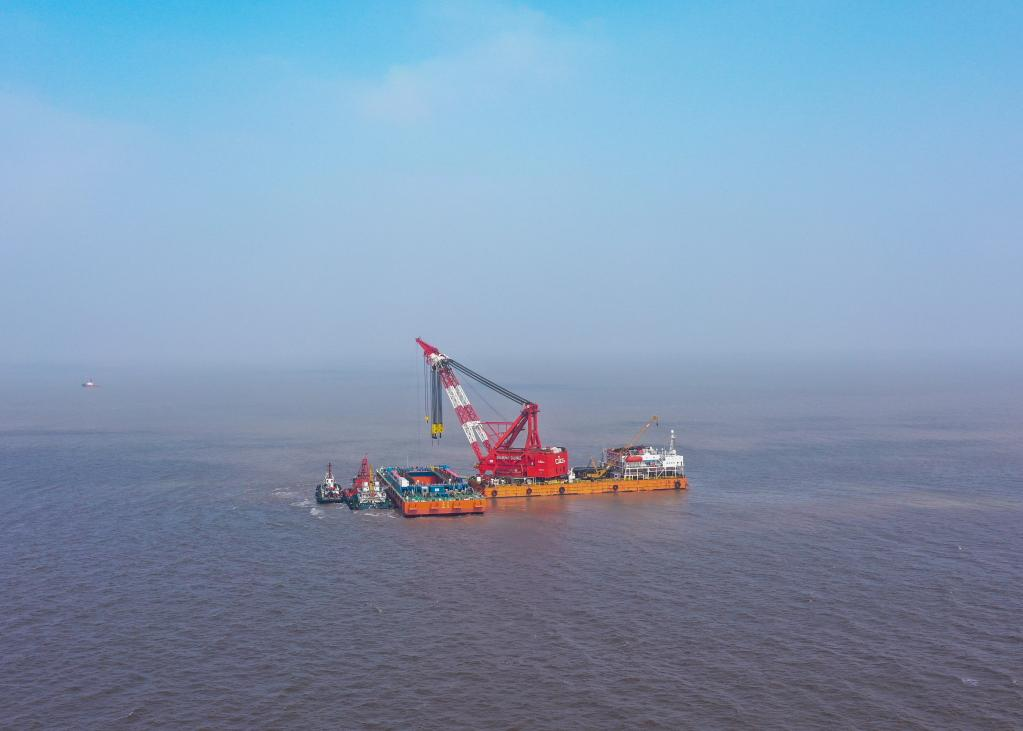
This aerial photo taken on Nov. 20, 2022 shows a view of the salvage operation of the Yangtze No. 2 Ancient Shipwreck in Shanghai, east China. An ancient shipwreck, one of the largest and best-preserved wooden shipwrecks discovered underwater in China to date, was lifted out of waters in Shanghai early Monday.
The Yangtze No. 2 Ancient Shipwreck dates back to the reign of Emperor Tongzhi (1862-1875) of the Qing Dynasty. This salvage could offer a useful glimpse of shipbuilding technology during the Qing Dynasty.
A milestone in China's underwater archaeology efforts, the sunken ship was detected in 2015 during a key underwater survey. (Xinhua/Ding Ting)
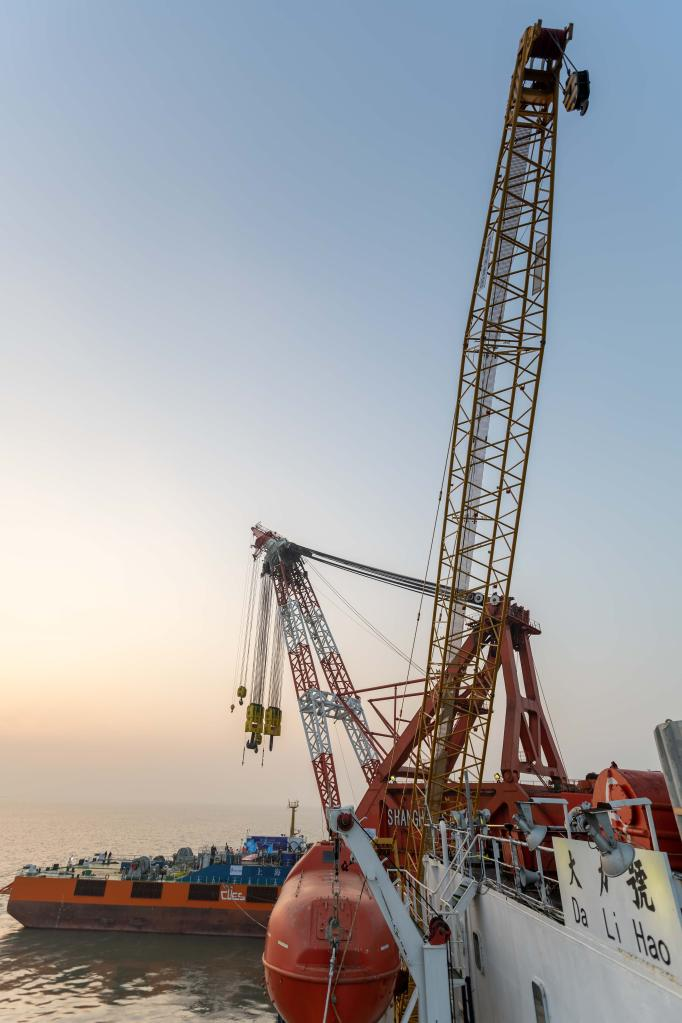
This photo taken on Nov. 20, 2022 shows a view of the salvage operation of the Yangtze No. 2 Ancient Shipwreck in Shanghai, east China. An ancient shipwreck, one of the largest and best-preserved wooden shipwrecks discovered underwater in China to date, was lifted out of waters in Shanghai early Monday.
The Yangtze No. 2 Ancient Shipwreck dates back to the reign of Emperor Tongzhi (1862-1875) of the Qing Dynasty. This salvage could offer a useful glimpse of shipbuilding technology during the Qing Dynasty.
A milestone in China's underwater archaeology efforts, the sunken ship was detected in 2015 during a key underwater survey. (Xinhua/Wang Xiang)
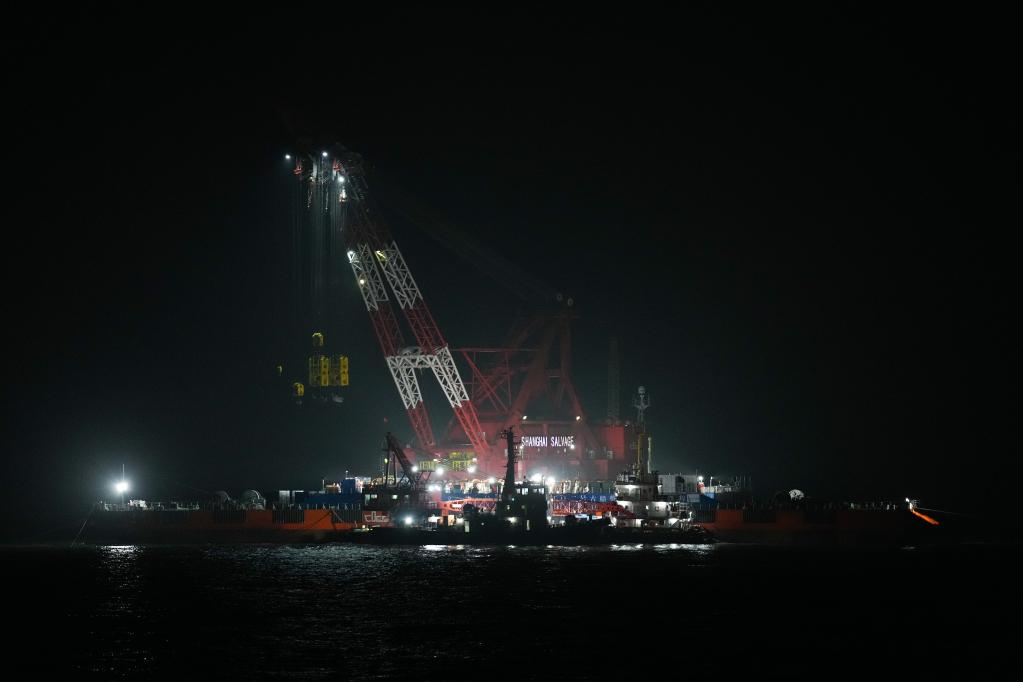
This photo taken on Nov. 20, 2022 shows a view of the salvage operation of the Yangtze No. 2 Ancient Shipwreck in Shanghai, east China. An ancient shipwreck, one of the largest and best-preserved wooden shipwrecks discovered underwater in China to date, was lifted out of waters in Shanghai early Monday.
The Yangtze No. 2 Ancient Shipwreck dates back to the reign of Emperor Tongzhi (1862-1875) of the Qing Dynasty. This salvage could offer a useful glimpse of shipbuilding technology during the Qing Dynasty.
A milestone in China's underwater archaeology efforts, the sunken ship was detected in 2015 during a key underwater survey. (Xinhua/Ding Ting)
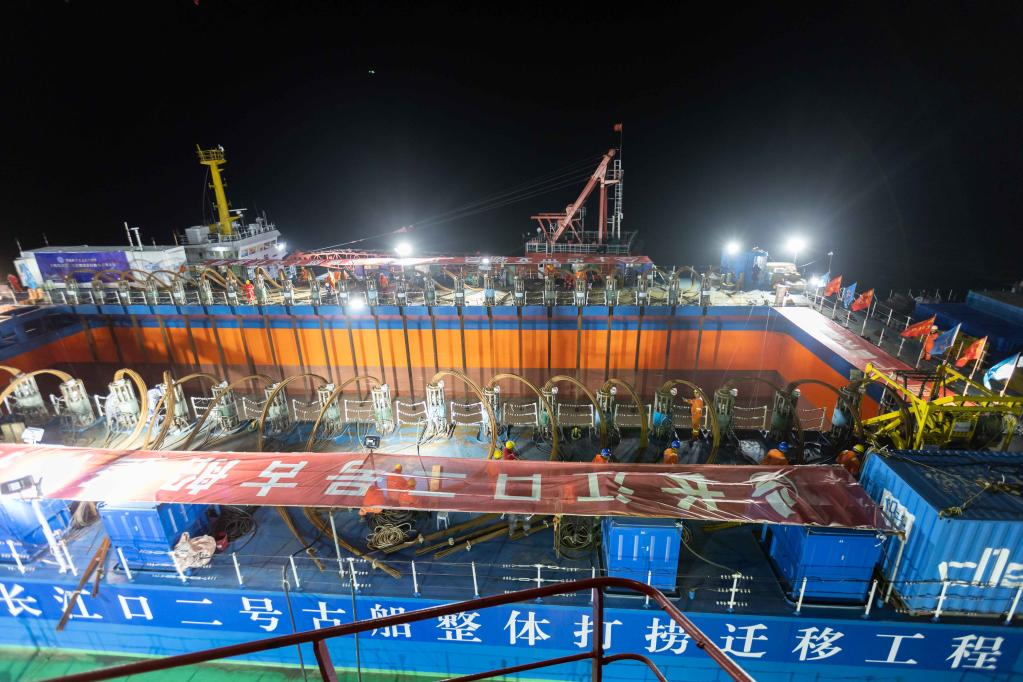
This photo taken on Nov. 20, 2022 shows a view of the salvage operation of the Yangtze No. 2 Ancient Shipwreck in Shanghai, east China. An ancient shipwreck, one of the largest and best-preserved wooden shipwrecks discovered underwater in China to date, was lifted out of waters in Shanghai early Monday.
The Yangtze No. 2 Ancient Shipwreck dates back to the reign of Emperor Tongzhi (1862-1875) of the Qing Dynasty. This salvage could offer a useful glimpse of shipbuilding technology during the Qing Dynasty.
A milestone in China's underwater archaeology efforts, the sunken ship was detected in 2015 during a key underwater survey. (Xinhua/Wang Xiang)
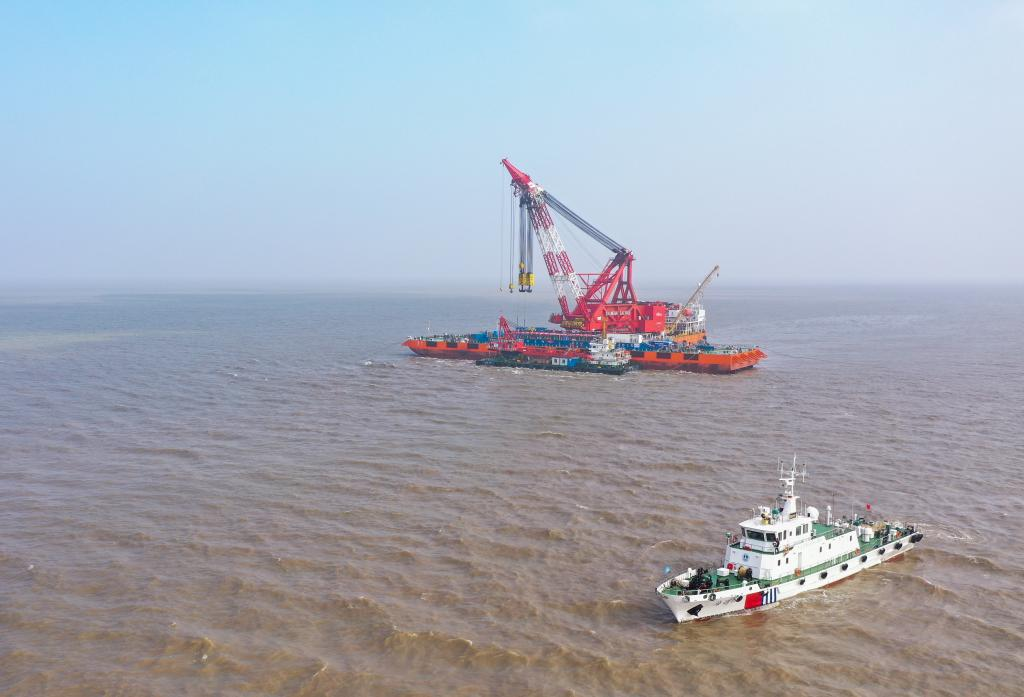
This aerial photo taken on Nov. 20, 2022 shows a view of the salvage operation of the Yangtze No. 2 Ancient Shipwreck in Shanghai, east China. An ancient shipwreck, one of the largest and best-preserved wooden shipwrecks discovered underwater in China to date, was lifted out of waters in Shanghai early Monday.
The Yangtze No. 2 Ancient Shipwreck dates back to the reign of Emperor Tongzhi (1862-1875) of the Qing Dynasty. This salvage could offer a useful glimpse of shipbuilding technology during the Qing Dynasty.
A milestone in China's underwater archaeology efforts, the sunken ship was detected in 2015 during a key underwater survey. (Xinhua/Ding Ting)
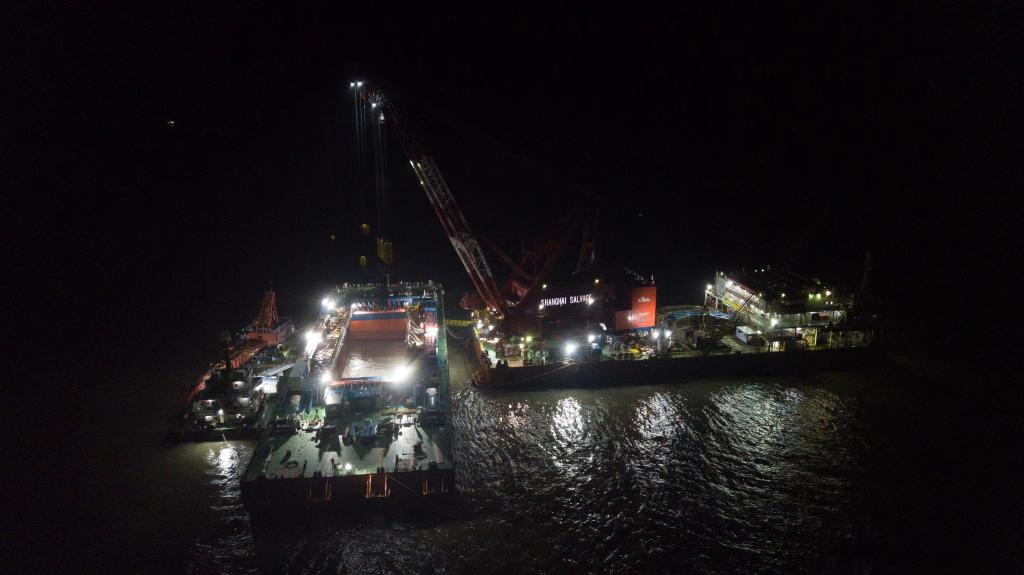
This aerial photo taken on Nov. 20, 2022 shows a view of the salvage operation of the Yangtze No. 2 Ancient Shipwreck in Shanghai, east China. An ancient shipwreck, one of the largest and best-preserved wooden shipwrecks discovered underwater in China to date, was lifted out of waters in Shanghai early Monday.
The Yangtze No. 2 Ancient Shipwreck dates back to the reign of Emperor Tongzhi (1862-1875) of the Qing Dynasty. This salvage could offer a useful glimpse of shipbuilding technology during the Qing Dynasty.
A milestone in China's underwater archaeology efforts, the sunken ship was detected in 2015 during a key underwater survey. (Xinhua/Jin Liwang)

This aerial photo taken on Nov. 20, 2022 shows a view of the salvage operation of the Yangtze No. 2 Ancient Shipwreck in Shanghai, east China. An ancient shipwreck, one of the largest and best-preserved wooden shipwrecks discovered underwater in China to date, was lifted out of waters in Shanghai early Monday.
The Yangtze No. 2 Ancient Shipwreck dates back to the reign of Emperor Tongzhi (1862-1875) of the Qing Dynasty. This salvage could offer a useful glimpse of shipbuilding technology during the Qing Dynasty.
A milestone in China's underwater archaeology efforts, the sunken ship was detected in 2015 during a key underwater survey. (Xinhua/Jin Liwang)
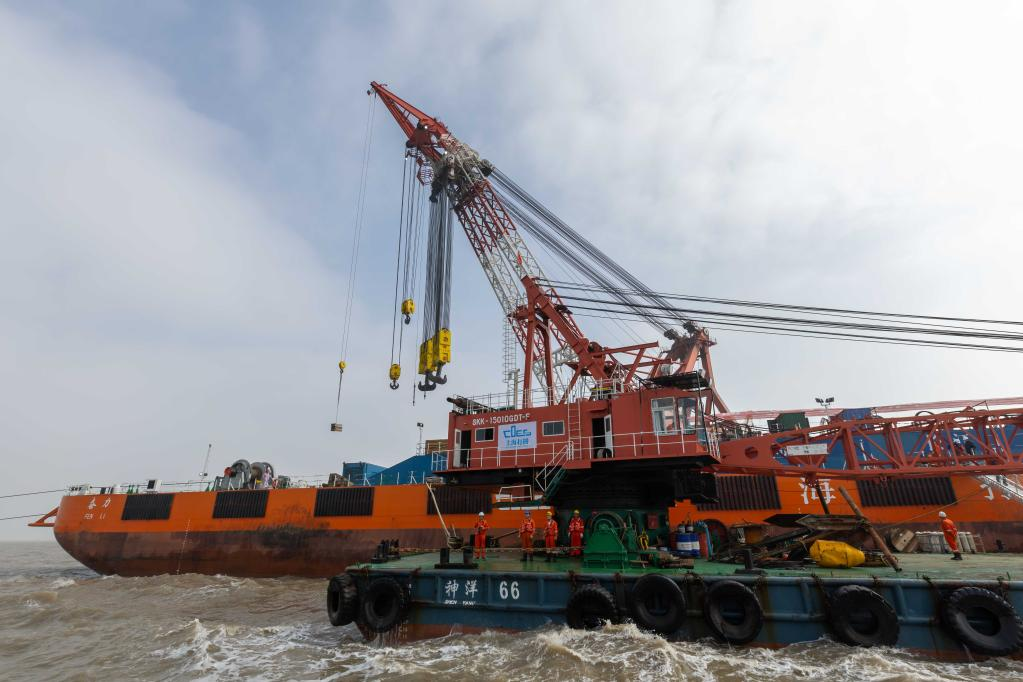
This photo taken on Nov. 20, 2022 shows a view of the salvage operation of the Yangtze No. 2 Ancient Shipwreck in Shanghai, east China. An ancient shipwreck, one of the largest and best-preserved wooden shipwrecks discovered underwater in China to date, was lifted out of waters in Shanghai early Monday.
The Yangtze No. 2 Ancient Shipwreck dates back to the reign of Emperor Tongzhi (1862-1875) of the Qing Dynasty. This salvage could offer a useful glimpse of shipbuilding technology during the Qing Dynasty.
A milestone in China's underwater archaeology efforts, the sunken ship was detected in 2015 during a key underwater survey. (Xinhua/Wang Xiang)



